
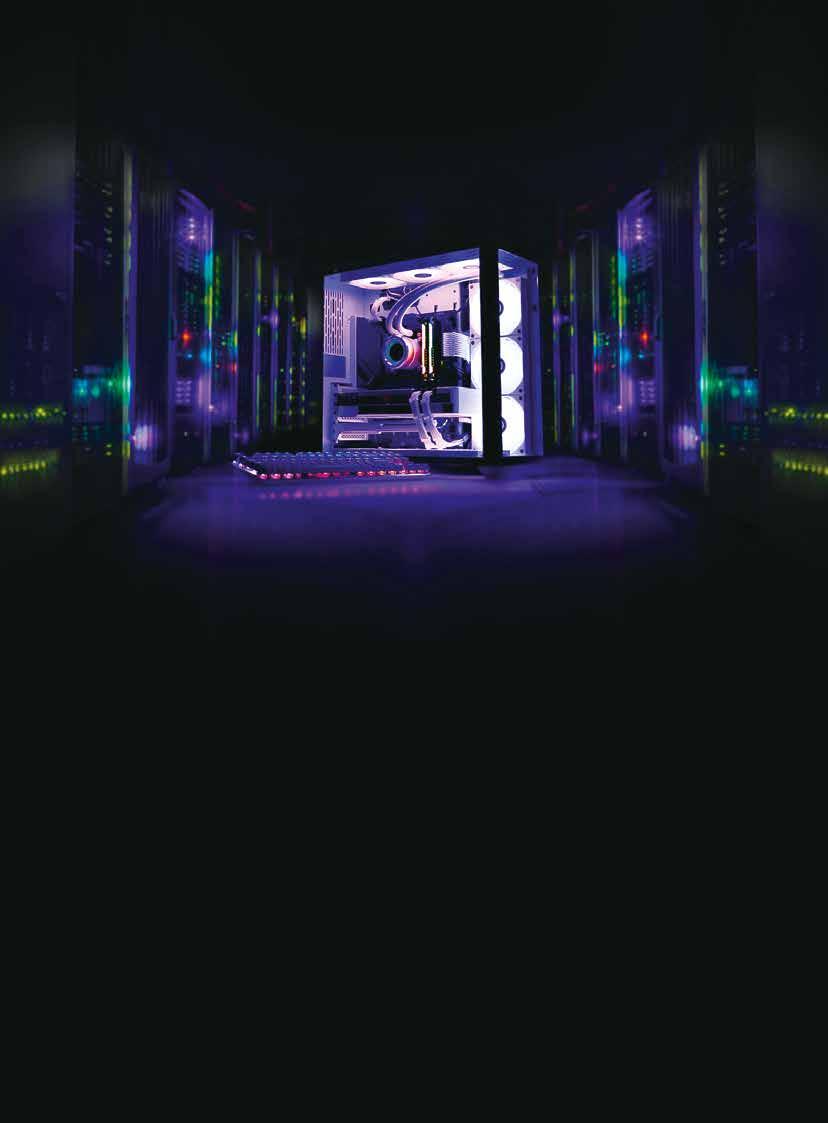





The technology narrative is entering a decisive new phase — one defined not by experimentation but by execution. The question is no longer if to embrace AI, automation, or hybrid cloud, but how fast, how securely, and how responsibly they can be scaled.
Technology leadership today goes beyond enabling innovation. It’s about building the foundations of trust, governance, and measurable value. These are the essentials on which true innovation can thrive.
Across industries, there’s now a clear consensus on the need to operationalize AI while maintaining data integrity and regulatory alignment. The Middle East is moving past pilot projects and into platform-scale adoption. As highlighted in our cover story, Dell Technologies is helping customers turn AI ambition into reality through end-to-end infrastructure that simplifies deployment and accelerates outcomes.
For CIOs and CISOs, the journey ahead will require rethinking architectures around security by design, hybrid multi-cloud environments, and AI-driven operations that predict rather than react.
Industry experts featured in this edition point to one defining shift — the integration of intelligence across every layer of the enterprise stack. The region’s technology ecosystem is finding a new balance, where AI, cyber resilience, and data governance work in unison. This convergence is no longer a choice; it’s a necessity. As companies deploy AI and automation more widely, their real success will come not just from how smart or fast their systems are, but from how securely and responsibly those systems are managed.
Enterprises are building smarter, more secure, and sustainable ecosystems that balance ambition with accountability. The future of enterprise transformation will not be driven by one technology alone but by the convergence of many — AI for insight, data for trust, and cybersecurity for assurance. That intersection is where the next decade of progress will unfold.
As GITEX celebrates its 45th edition, one can expect this convergence to take center stage.
R. Narayan Editor in Chief, CXO DX
RAMAN NARAYAN
Co-Founder & Editor in Chief narayan@leapmediallc.com Mob: +971-55-7802403
Ali Raza Designer
SAUMYADEEP HALDER
Co-Founder & MD saumyadeep@leapmediallc.com Mob: +971-54-4458401
Nihal Shetty Webmaster
MALLIKA REGO
Co-Founder & Director Client Solutions mallika@leapmediallc.com Mob: +971-50-2489676
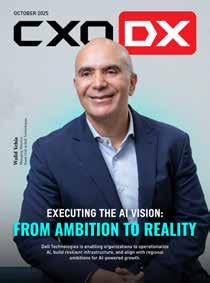
18 » EXECUTING THE AI VISION: FROM AMBITION TO REALITY
Walid Yehia, Managing Director, Gulf at Dell Technologies, shares how the company is enabling organizations to operationalize AI
28 » THE NEW AXIS OF ENTERPRISE
TRANSFORMATION
AI, Data, and Cybersecurity Converge to Power the Next Wave of Digital Transformation
36 » TRANSFORMATION IN AN ERA OF CONVERGENCE
54 » FROM FOUR-DAY WEEKS TO FLEX DESKS: THE GULF’S WORKPLACE SHIFT
14 » GLOBAL TECH LEADERS CONVERGE AT GITEX GLOBAL 2025
16 » MBUZZ SHOWCASES DISRUPTIVE INNOVATION WITH ADVANCED COMPUTING TECHNOLOGIES
24 » DRIVING SECURE AND AUTONOMOUS IT OPERATIONS
34 » HUMAN-FIRST CYBERSECURITY WITH GENAI INNOVATIONS
40 » EMPOWERING THE CONNECTED FUTURE
42 » DRIVING RESPONSIBLE AI ADOPTION
44 » RAISING THE BAR FOR HIGH PERFORMANCE STORAGE
Regional CXOs share how AI, cloud, and cybersecurity are converging to reshape enterprise strategy 06 » NEWS 64 » TECHSHOW 66 » TRENDS & STATS
56 » REFLECTIONS ON AI, LEADERSHIP, AND THE FUTURE OF IT
26 » UNLOCKING THE NEXT WAVE OF PARTNER
48 » SPOTLIGHT ON DIGITAL-FIRST WORKPLACE
58 » THE HYBRID ORG CHART: WHEN AI AGENTS START ORGANIZING STRUCTURES OF LEADERSHIP
60 » DELIVERING ON THE PROMISE OF DEVOPS

With the theme “AI-Enabled Collaboration,” Logitech will showcase its latest workplace solutions
Logitech announced its participation at GITEX Global 2025, to be held in Dubai from October 13th to 17th, 2025. Focusing on the theme “AI-Enabled collaboration,” Logitech will present AI-powered, human-centric products that will let visitors experience how smart collaboration tools work in a future-ready, sustainable workplace.
Commenting on their participation at GITEX Global 2025, Murad Ali, Head of GCC Logitech for Business said, “GITEX is a great platform to highlight our latest innovations in smart collaboration to our customers in the region. With the Middle East becoming a global player in digital transformation, our solutions empower businesses to embrace emerging work trends that help them stay competitive. Our sustainable designs also ensure that
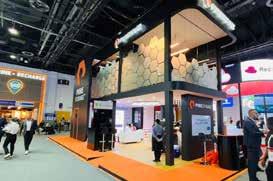
Pure Storage will showcase Enterprise Data Cloud (EDC), an industry-changing architectural approach to data storage and management from its booth B30 in Hall 5 at GITEX Global.
Businesses in the Middle East are grappling with rising data complexity, the pressure to modernise applications, and the need to ensure cyber resilience. Against this backdrop, they are looking for energy-efficient storage solutions that can meet the demands of AI workloads and High-Performance Computing (HPC), be consumed as-a-service, and bring clarity and control to data management at scale.
The Pure Storage EDC is an intelligent data
our products are built to last and are easy to recycle.”
Attendees will have the opportunity to experience Logitech’s comprehensive lineup of video conferencing tools, including upcoming products that will be shown for the first time. Through these new technologies, businesses will be able to visualize how their workspaces can better fit the needs of their employees, whether they’re working in the office or remotely. Visitors will also get to preview Logitech’s Personal Workspace Solutions designed to help employees get things done from anywhere, with more security, flexibility and comfort. These include an ecosystem of high-quality products such as mice, keyboards, webcams and headsets.
The company also affirms its sustainabil-

ity goals with its Design for Sustainability approach. These include factors that consider the environmental impact when creating a product, from sourcing raw materials to the end-of-life cycle.
Experts from Logitech will be available at their booth at Hall 3-C30 to meet with customers and partners and demonstrate the power of their solutions at the event.
Pure Storage’s Enterprise Data Cloud enables customers to meet the demands of AI and HPC, drive energy efficiency, and navigate data sovereignty challenges
architecture that sets a bold new standard for data and storage management, enabling regional organisations to focus on business outcomes, rather than the underlying infrastructure. By eliminating silos, reducing complexity, and dramatically lowering power and space consumption, it empowers enterprises to unlock the full value of their data, enhance agility, and future-proof their infrastructure, all while achieving significant gains in energy efficiency.
As demand for AI, HPC, and GPU-as-aService capabilities accelerates across the region, success now depends on data, not just algorithms or compute. The global drive for AI gigafactories, and increased global awareness of data sovereignty capabilities has amplified concerns around where data resides.
Moreover, geopolitical uncertainty, the threat of foreign influence over data, and regulatory pressure mean organisations in
the Middle East are increasingly focused on data sovereignty. The risk of service disruption is no longer theoretical and organisations need to consider who has access to their data.
Pure Storage enables organisations to navigate this complexity with an architectural approach encompassing hardware, software and services that deliver transparency, agility, and are future-proofed to meet digital strategies.
“To fully seize the incredible opportunity that AI and other transformative technologies present, it’s time organisations stopped managing storage and started managing data,” said Omar Akar, Regional Vice President, METCA, Pure Storage. “Our goal is to remove complexity and make storage almost self-driving by bringing together infrastructure, intelligence, and integrated services into one consistent experience.”

Ahmad Alkhallafi Managing Director UAE & Africa, HPE
HPE returns to GITEX this year with a bold new brand. For the 45th edition of the established and iconic tech exhibition, HPE will showcase how it empowers organisations to optimise operational performance, transform data into foresight, and maximise their impact, with a comprehensive solutions portfolio.
At stand A30 in Hall 6 visitors will have the opportunity to engage with HPE’s technical experts and learn about the latest innovations.
Visitors to experience key advancements in AI, networking, and hybrid cloud and learn more HPE’s leading AI solutions
Key highlights of the HPE GITEX 2025 stand will include:
• The Artificial Intelligence solutions portfolio. The portfolio provides integrated end-to-end solutions and services, removing the complexity of customers having to compile a full AI tech stack on their own when building a modern AI-ready data centre, with:
» HPE AI factory solutions, including new composable solutions optimised for service providers, model builders and sovereign entities
» HPE Private Cloud AI, the turnkey AI factory for enterprises.
• The 100% fanless direct liquid cooling (DLC) systems architecture: This innovation enhances the energy and cost efficiency of large-scale AI deployments. It yields 90% reduction in cooling power consumption as compared to traditional air-cooled systems.
• The comprehensive HPE Networking portfolio: Combining the leading solutions of HPE Aruba Networking and HPE Juniper Networking, this portfolio provides customers with a leading AI-native and secure foundation for their end-to-end networking needs.
“For HPE, GITEX 2025 not only marks the 45th edition of the crucial event, but also a moment to celebrate the 10th anniversary of HPE as a standalone company,” said Ahmad Alkhallafi, Managing Director for United Arab Emirates & Africa at HPE. “As such we will showcase a bold new brand and a clear message: We are the essential partner for the AI era. For the UAE, as it strives for an integrated and technologically advanced infrastructure to realize its Vision 2031, and for our customers and partners in the region, helping them move faster, scale smarter, and unlock new opportunities.”
Mohammed Amin President, CEEMETA, Dell Technologies
The company will highlight AI-first design, sustainable innovation, and strategic partnerships at its booth C70 in hall 2
ASUS will be exhibiting a wide range of its AI-powered devices at the 45th edition of GITEX GLOBAL under the theme “Ubiquitous AI. Incredible Possibilities.” Furthermore, ASUS will bring together its AI portfolio giving visitors a firsthand look at how intelligent technology is reshaping industries.
“The Middle East stands at a decisive point in its digital transformation, with AI shaping the way economies, institutions, and communities move forward. GITEX GLOBAL is an opportunity for us to show our latest advancements and strengthen relationships with our customers and partners across the region,” says Tolga Özdil, Regional SYS Commercial Director, META, ASUS.
ASUS will be presenting a strong lineup of devices designed for business and education. This includes the B5405 with an ergo-
nomic design, the P5405 with a 47 TOPS NPU made for AI tasks, and the B9403 that weighs less than 1 kg and comes with an all-day battery life. All ExpertBook Copilot PCs are engineered with MIL-SPEC magnesium-lithium alloy chassis for extreme durability. There’s also the Chromebook CX5403 Plus, CR1204, and the Windows BR1204, made for students with durable and secure designs. The CX1405 Chromebook Plus laptop includes 12 months of Google One AI Premium, and the P470 and P440 All-in-One (AiO) PCs, engineered for durability and easy serviceability. ASUS will also demo AI ExpertMeet, an intelligent collaboration solution.
Visitors will also get to see ASUS’s Infrastructure AI solutions that include the ASUS AI POD (with NVIDIA GB300), HGX servers, and Ascent GX10 powered by the NVIDIA GB10 Grace Blackwell Superchip. Work-

Tolga Özdil
Regional SYS Commercial Director, META, ASUS
space AI lineup, including the NUC 15 Pro, NUC 14 Pro AI, and ROG NUC 2025 mini PCs, all designed for compact and powerful enterprise computing. ASUS revolutionizes smart cities by exploring cutting-edge solutions powered by the robust embedded computer PE2200U and the powerful Edge AI systems PE6000G and PE2100N. The Productivity AI solutions include the ASUS ProArt and Go series networking solutions.
Under the theme ‘Make AI Work for You’, Cisco will showcase at GITEX GLOBAL 2025, its latest innovations designed to accelerate AI adoption for organizations in the region.
At GITEX GLOBAL 2025, Cisco, will showcase its latest innovations designed to simplify, secure, and accelerate AI adoption for organizations navigating the rapidly evolving digital landscape.
As enterprises in the region face increasing pressure to adopt and maximize their AI investments, under the theme ‘Making AI Work for You’, Cisco will demonstrate how its solutions can help businesses connect, protect, and thrive in an AI-driven world:
• AI-Ready Data Centers: Modernizing and transforming data centers to power traditional and AI workloads anywhere with speed, scale, and flexibility.
• Future-Proofed Workplaces: Creating agile environments that evolve with employee needs and deliver superior customer experiences.
• Digital Resilience: Keeping organiza-
tions securely up and running by preventing major issues, remediating problems quickly, and adapting to change to capture new opportunities..
Abdelilah Nejjari, Managing Director for the Gulf and Levant Region at Cisco, commented: "As organizations in the UAE and wider region strive to bridge existing gaps in AI adoption, the demand for robust, secure, and AI-optimized infrastructure is growing. Such infrastructure is essential to fully realize AI's transformative potential. Our participation at GITEX this year underscores Cisco’s commitment to helping businesses across the region adopt AI confidently.”
Cisco will showcase comprehensive innovations to help businesses automate workflows, enhance decision-making, and unlock new levels of efficiency and competitiveness, including but not limited to simplified
Data Resilience Maturity Model (DRMM) highlighted as a framework for enterprises to benchmark their resilience posture
At GITEX GLOBAL 2025, Veeam Software will showcase how its expanded Veeam Data Platform, Veeam Data Cloud, and the recently launched Data Resilience Maturity Model (DRMM), empowers organizations to measure, strengthen, and achieve radical resilience in the face of escalating cyberthreats.
Mena Migally, Regional VP - EMEA East at Veeam Software, said, “ At Veeam, we believe resilience must be measurable, intelligent, and proactive. This is why we’re introducing the Data Resilience Maturity Model (DRMM) as a framework for enterprises to benchmark their resilience posture and take actionable steps to reduce downtime, protect brand trust, and secure business continuity.”
Veeam will showcase its solutions at stand B20 in hall 7. Key innovations and announcements include:
• Cyber Secure Program Enhancements:
AI-driven malware detection, clean-room recovery, and an expanded ransomware warranty.
• Data Resilience Maturity Model (DRMM): A new strategic framework to help organisations assess and advance their resilience capabilities.
• Veeam Data Cloud (VDC): Veeam’s unified Backup-as-a-Service offering for Microsoft 365 and Azure.
• Veeam Software Appliance: The company recently launched its first-ever fully prebuilt, pre-hardened, software-only appliance for data resilience and completely hardware-agnostic, empowering customers to deploy on their preferred infrastructure without hardware lock-in.
• Live Demos: Instant Recovery, CleanRoom Recovery, AI-powered threat detection and response, DRMM assessment tools, and multi-cloud data portability.
• Partner Ecosystem: Joint demos and co-presentations with leading technology

operations with AgenticOps, enhanced security for the AI era and intelligent workplaces.
The urgency for these innovations is highlighted in Cisco’s 2025 AI Readiness Index. Recognizing AI as a significant workload multiplier, nearly all UAE organizations plan to build new data center capacity within five years, with 52% anticipating this need within just 12 months.
Splunk, a Cisco Company, will also have a significant presence within Cisco’s booth. Cisco will present its innovations in Hall 22 – Stand C20.

partners.
• Channel Enablement: New training initiatives and expanded distributor collaborations.
• Ransomware Insights: Release of the 2025 Veeam Ransomware Trends & Proactive Strategies Report.
• Complementary Solutions and Partner Innovations: Veeam will also spotlight integrations and joint innovations with key ecosystem collaborators, including ExaGrid, Red Hat, Object First, Alpha Data, and BPS.
Sophos will showcase its latest AI-driven solutions at its dedicated booth in Hall 23, Booth 50.
At GITEX Global, Sophos is set to showcase its advanced innovations such as Managed Detection and Response (MDR), Active Threat Response and the new Sophos Endpoint—now seamlessly integrated into all Taegis XDR and MDR subscriptions highlighting how AI is transforming modern cyber defense. Sophos Field CISO John Shier will be attending GITEX Global, where he will meet with customers and partners to discuss the future of AI and cybersecurity.
As digital transformation is evolving in the Middle East, so are cyber threats. Organizations are now facing increasingly complex and costly cyberattacks from ransomware and business email compromise to AI-driven threats such as automated phishing, deepfake fraud, and AI-augmented malware. Traditional defenses are not enough to mitigate these threats. According to the latest Sophos State of Ransomware report, ransomware
remains a major threat to organizations in the UAE, with 43% of affected organizations paying a ransom and recovery costs averaging $1.41 million, including downtime, remediation, and lost opportunities. This indicates the urgent need for organizations to move beyond basic prevention to adopt proactive, intelligence-driven defenses such as detection, response, and cybersecurity-as-a-service.
“As AI adoption accelerates, businesses are increasingly implementing a security-first mindset to tackle the growing complexity of digital transformation. For Sophos, this is a chance to deliver real-world solutions and highlight our regional investments through our upcoming local data center, partnerships, and services,” said Harish Chib, Vice President Emerging Markets, Middle East & Africa, Sophos.
E-7 Cyber enables organizations to strengthen data protection, maintain regulatory compliance, and safeguard intellectual property

E-7 Cyber, a UK-based headquartered cybersecurity innovator, has announced a strategic partnership with Bulwark Distribution FZCO, one of the Middle East’s leading value-added distributors for IT and cybersecurity solutions. This collaboration represents a major step toward delivering next-generation security platforms to enterprises, government agencies, and organizations across the region.
The company’s flagship offerings include:
• Blindspot: A next-generation data privacy solution designed to prevent insider-driven data leaks.
• Vigilance: Advanced monitoring of critical data, enforcing identity-based digital footprints, and delivering comprehensive compliance tracking.
• Regulatory Security Platforms: Streamlined solutions to ensure adherence to global and regional data protection regulations. With these solutions, E-7 Cyber enables organizations to strengthen data protection, maintain regulatory compliance, and safeguard intellectual property in an increasingly complex digital landscape.
The alliance is built on three strategic pillars that define its regional vision. The first focuses on market expansion, leveraging Bul-

Harish Chib Vice President Emerging Markets, MEA, Sophos
After its February 2025 acquisition of Secureworks, Sophos has now enabled Taegis XDR customers to use Sophos Endpoint, enhancing protection and ROI. At GITEX Global, Sophos will focus on its commitment to securing digital transformation through AI-driven cybersecurity. At the event, Sophos will showcase its product ecosystem, including advisory services, endpoint and network security, and MDR, demonstrating how it enables organizations to build resilience and align with national cybersecurity strategies through integrated, adaptive protection and recovery capabilities.
wark’s strong channel ecosystem to extend the reach of E-7 Cyber’s enterprise-grade platforms across MENA. The second emphasizes cybersecurity readiness, addressing rising threats and compliance pressures from rapid digital transformation with advanced insider-threat prevention and regulatory security solutions. The third pillar centers on digital resilience, enabling organizations to adopt scalable, cost-effective platforms that strengthen defenses, ensure business continuity, and maintain compliance in an evolving threat landscape.
Heena Sharma, Chief Operations & Growth Officer of E-7 Cyber said, “We are excited to partner with Bulwark, a trusted name in cybersecurity distribution. With this collaboration, we can scale our reach, bring our innovative data protection platforms to a wider audience, and help businesses in the Middle East strengthen compliance and insider-threat prevention.”
“We’re excited to partner with e-7 Cyber,” said Jose Menacherry, Managing Director at Bulwark Distribution FZCO. “This collaboration allows us to strengthen our security portfolio and better serve our customers’ needs for faster, more accurate threat protection including digital watermarking and protection.”
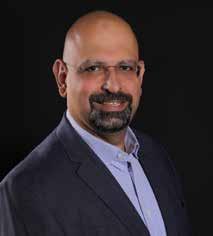
At GITEX GLOBAL, Cloudflare Inc will highlight the Connectivity Cloud — its flagship solution that unifies security, performance, and developer services into a single, programmable platform. Cloudflare will demonstrate how the Connectivity Cloud integrates with a range of cutting-edge capabilities that address the most pressing needs of private and public organisations today. Visitors to Cloudflare’s stand at Booth H8-B40, Hall 8 will experience innovations across three key areas:
• Secure Access Service Edge (SASE) and Security Service Edge (SSE)
» AI Crawler Control — Empowering organizations to decide which AI crawl-
Powers the next era of secure, AI-aware connectivity in the Middle East
ers can access their content, block unauthorized scraping by default, and even monetize permitted access through a “pay per crawl” model.
» Bot Management for Public Interest — Helping independent journalism and nonprofit organizations defend against malicious bots and unauthorized AI scraping.
» Zero Trust Integrations with Microsoft Entra ID — Delivering stronger identity-driven security controls that reduce enterprise risk.
» DDoS Defense at Internet Scale — Showcasing Cloudflare’s unmatched ability to mitigate record-breaking, multi-terabit DDoS attacks automatically.
• Fast Application Delivery & Network Infrastructure
» Connectivity Cloud Core Capabilities — Unifying networking, security, and developer services in a single programmable platform that powers AI-ready, global-scale applications.
» Workers VPC and Private Link — Offering secure, isolated environments for developers to build and connect crosscloud applications with performance and compliance in mind.
• Full-Stack Development & Insights
» AI Insights via Cloudflare Radar — Providing real-time visibility into how AI models are crawling and consuming web content.
» Workers Developer Platform Enhancements — Enabling organizations to rapidly build, deploy, and scale modern applications directly on Cloudflare’s edge network with the use of AI.
“Through our Connectivity Cloud, we provide the foundation for fast application delivery and resilient network infrastructure across the region. And with our full-stack developer platform, we empower innovators to build and scale applications closer to their users than ever before,” said Bashar Bashaireh, AVP Middle East, Türkiye & North Africa at Cloudflare.
Showcase will highlight innovative AIoT capabilities and regional use cases
Cumulocity, a global leader and independent end-to-end AIoT platform, will return to GITEX Global 2025 alongside regional partner Mindware at Hall 2, Booth A30. Under the theme, ‘From Automation to Autonomous’, Cumulocity will highlight innovative AIoT capabilities and regional use cases, demonstrating how organizations can leverage the combined power of AI and IoT to drive digital services, operational efficiency, and new business models.
As a cloud-agnostic, low-code platform with open integration capabilities, Cumulocity empowers customers to focus on generating business value while solving critical technical challenges and enhancing operational efficiencies. The platform enables users to connect and manage devices, rapidly develop and analyze IoT applications, and operate them with predictive AI capabilities, at the edge, in the cloud, or on-premises. Cumulocity provides an open, independent, and scalable platform
for smart connected products and autonomous operations. Trusted by enterprises and government worldwide, Cumulocity supports diverse industries with use cases ranging from fleet management and smart energy grids to manufacturing process optimization.
Nasri Nassereddine, Vice President – Middle East, Turkey, and Africa, Cumulocity, stated, “The rise of Artificial Intelligence is reshaping the IoT landscape. Enterprises no longer seek mere automation; they demand truly autonomous systems. At GITEX Global, Cumulocity will demonstrate how our AIoT platform bridges this gap, delivering actionable intelligence and operational agility that translate into measurable business value. Visitors can experience first-hand how AI and IoT together unlock new possibilities for innovation and efficiency across industries."
Cumulocity also brings a strong ecosystem
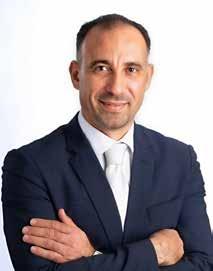
Vice
of global hyperscalers, regional telcos, and system integrators, enabling partners and customers to address complex business requirements with confidence. This partner-first approach ensures scalability, localisation, and sector-specific expertise for every deployment.
SC AN QR CODE FOR MORE DE TAIL S


SC AN QR CODE FOR MORE DE TAIL S
MAGIC 2.0, the latest evolution of the company’s proprietary digital platform will be officially launched at GITEX
Mindware, a leading value-added distributor (VAD) in the Middle East and Africa, returns to GITEX Global 2025 with a focus on Artificial Intelligence, reinforcing its commitment to empowering regional businesses through cutting-edge innovation, advanced infrastructure, and next-generation cybersecurity.
With this year’s theme, “Artificial Intelligence: The Next Frontier,” Mindware aims to demonstrate how AI can be a transformative force for enterprises across the region. At the centre of its showcase will be the official launch of MAGIC 2.0, the latest evolution of the company’s proprietary digital platform. This powerful new iteration will offer real-world AI-driven use cases, deliver enhanced capabilities for intelligent transformation, and support deeper integrations across cloud and cybersecurity ecosystems.
Mindware’s presence at GITEX will be anchored around three strategic goals: build-
ing high-impact strategic engagements, unveiling its latest AI innovations, and further solidifying its role as the region’s most trusted value aggregator for technology solutions and services. Philippe Jarre, CEO & President, Mindware, commented, “As digital transformation sweeps across the region, AI and cybersecurity are no longer optional; they’re foundational. At GITEX 2025, we’re excited to demonstrate how Mindware is helping customers and partners harness AI to drive real-world results.”
Throughout the week, Mindware will feature a dynamic line-up of product demonstrations covering AI, cloud, and cybersecurity solutions, including collaborations with global vendors such as Dell Technologies, NVIDIA, Microsoft, AWS, Google Cloud, RSA, Splunk, Trend Micro, Ubiquiti, Archer, Siav and Everfox to name a few. Joint demos and co-presentations will highlight how AI can be applied in diverse verticals through the MAGIC platform. Visitors will also benefit from spotlight

Philippe Jarre CEO & President, Mindware
sessions, exclusive show-only promotions, and hands-on training initiatives aimed at empowering partners with AI-related skills.
The company’s momentum in 2025 is further highlighted by its recent strategic partnerships with IBM in Saudi Arabia and Autodesk across the UAE and KSA. Mindware also expanded its geographic reach with the launch of operations in East Africa in January 2025, further solidifying its presence in high-growth markets. Mindware will be showcasing its solutions at stand H2-A30 during GITEX.
Built for modern security teams, Securonix equips organizations with a unified platform that detects threats, analyzes behavior, and responds at machine speed

AmiViz, a leading cybersecurity-focused value-added distributor, has entered into a strategic distribution agreement with Securonix, a five-time Gartner Magic Quadrant Leader in Security Information and Event Management (SIEM).
This collaboration brings Securonix’s cutting-edge, AI-driven threat detection, investigation, and response solutions to organizations across the Middle East and East Africa, helping them stay ahead of increasingly sophisticated cyber threats.
“We’re proud to partner with Securonix, a recognized leader in the SIEM space,” said Ilyas Mohammed, COO at AmiViz. “As cyber threats evolve in complexity, our focus remains on delivering intelligent, scalable security solutions that empower our partners and clients. Se-
curonix’s AI-based capabilities are a powerful addition to our portfolio.”
Built for modern security teams, Securonix equips organizations with a unified platform that detects threats, analyzes behavior, and responds at machine speed. Designed for the cloud, powered by agentic AI and built to scale, it empowers global enterprises and government agencies to stay resilient in a constantly shifting threat landscape.
“We’re excited to work with AmiViz to expand our footprint in the region,” said Ajay Biyani, Vice President - APMEA, Securonix. “Their deep expertise and strong presence make them an ideal partner to deliver our next-generation security operations platform to organizations navigating today’s dynamic threat landscape.” As digital transformation accelerates, this partnership positions both companies to support enterprises seeking proactive, AI-enhanced cybersecurity strategies in an era of growing digital risk.
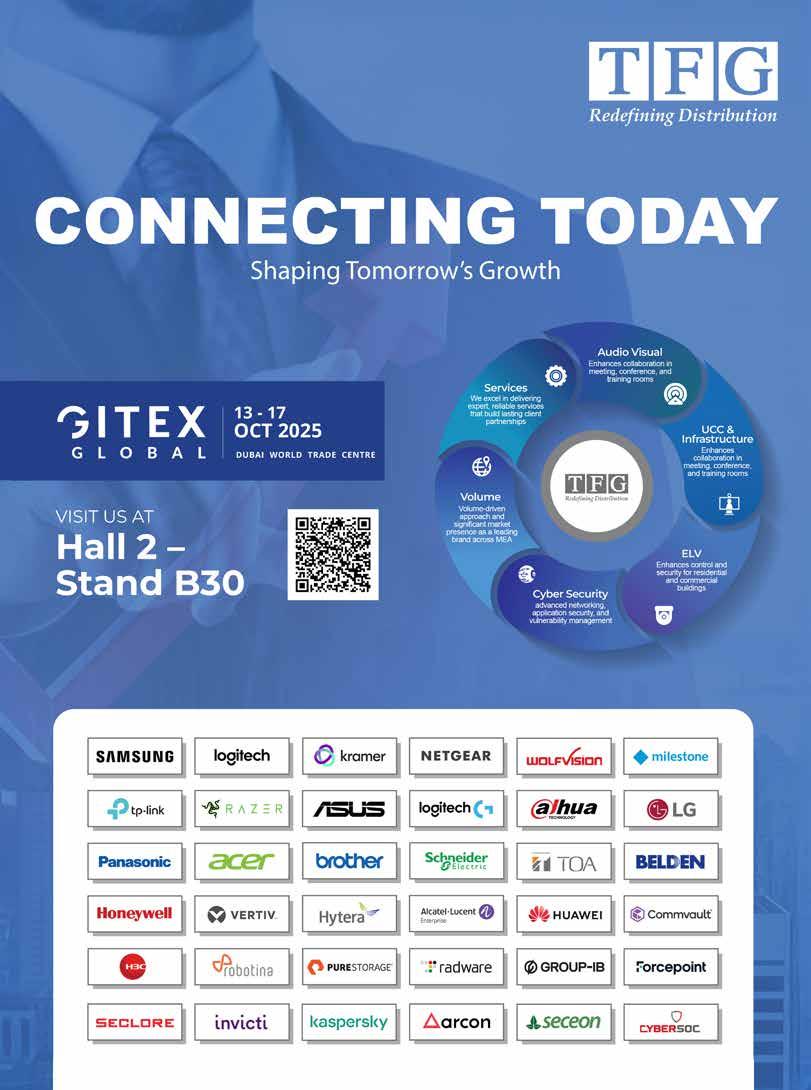
Landmark 45th edition of GITEX GLOBAL brings together the world’s most advanced AI and tech enterprises and leaders from 180 countries, from 13-17 October at Dubai World Trade Centre
With the global AI market set to reach $4.8 trillion by 2033 (UNCTAD), the race to deploy AI for critical sectors has never been more urgent. Against this backdrop, GITEX GLOBAL 2025 convenes as the world’s largest tech and AI event, with this year’s edition highlighting significant developments in biotech, physical AI, quantum computing, semiconductors, and data centres.
From 13-17 October at Dubai World Trade Centre, the show unites over 6,800 tech enterprises and 2,000 startups, with participation from 180 countries, bringing together the companies leading the world’s most ambitious AI infrastructure expansion. Global tech enterprises including Alibaba Cloud, AMD, AWS, Dell, e&, G42, Google, HPE, Huawei, IBM, Microsoft, Oracle, Salesforce, Siemens, and Snowflake anchor the showcase, with new incoming innovations from Cerebras, Datadog, Mitsubishi, Qualcomm, Rital, ServiceNow, Tata Electronics, Telecom Italia, and Tenstorrent.
Running in parallel is GITEX’s startup showcase, Expand North Star, from 1215 October at Dubai Harbour, hosted by the Dubai Chamber of Digital Economy. Celebrating its 10th edition, the show connects 2,000 of the world’s most promising startups, with the highest percentage of growth & late-stage startups anywhere, with over 1,200 investors managing US$1.1 trillion assets.
Trixie LohMirmand, EVP of DWTC, the organiser of GITEX globally, shared, “Future-critical sectors including data centres, biotech, quantum, and robotics are where AI ingenuity is converging with humanity’s most pressing challenges. GITEX GLOBAL 2025 gives new impetus to these transformative technologies, while continuing to being the harbinger of innovation-led progress across industries and global economies.”

With global data centre investments set to exceed $500 billion in 2025 (BofA Research), GITEX GLOBAL welcomes one of the biggest global investors in this sector, O’Leary Ventures, building the world’s largest AI data centre industrial park in Canada.
Adding a regional perspective, Hassan Alnaqbi, CEO of Khazna, MENA’s largest hyperscale data centre provider and a G42 company, leads the discussions on whether infrastructure, energy and policy can scale fast enough to keep pace with giga AI factories.
Breakthroughs in gene editing, mRNA vaccines and AI-led drug discoveries are driving biotech spending towards $1.7 trillion in 2025 – setting the backdrop for the fastest AI deployment in this sector. At GITEX GLOBAL, Trevor Martin, CEO of Mammoth Biosciences, presents how CRISPR, their Nobel winning gene-editing technology, is using AI to potentially cure genetic diseases. Matt Angle, CEO of Paradromics, the company behind the world’s first successful computer-brain implant, dives into decoding thought with AI and neurotech. Adding to this momentum, South Korean startup HurayPositive unveils AI-powered
SaaS to deliver precision medicine for one million patients with chronic conditions.
At GITEX GLOBAL, Tensor unveils the world’s first personal robocar – globally applauded as “agentic AI on wheels”. Whilst K2 introduces new humanoids and a concept vehicle designed to extend robotics into industrial environments.
On the show floor, IBM unveils Quantum System Two, a major step towards large-scale fault-tolerant systems capable of solving computing scale challenges. Prof. Mark Thompson, Co-Founder of PsiQuantum, a $6 billion unicorn, outlines the path towards quantum sovereignty. Among the headline exhibitors is also IONQ, the world's first public pure-play quantum computing company trading at the New York Stock Exchange.
Global leader in high-performance processors, AMD presents its Instinct GPUs and EPYC CPUs, built to handle the most demanding AI workloads and energy-efficient data centre deployments.
Expand North Star features more than 40 unicorns this year, reinforcing the UAE’s position as a hub for global scale-ups.
Visitors to the MBUZZ booth (A30, Hall 1) will be able to experience a comprehensive lineup of next-generation computing and integration solutions firsthand.
MBUZZ, a leading technology solutions provider and value-added distributor, is making a strong presence at GITEX Global 2025, highlighting its expanding portfolio of AI and High-Performance Computing (HPC) infrastructure solutions. Visitors to the MBUZZ booth (A30, Hall 1) will have the opportunity to explore a wide range of next-generation compute and integration solutions from leading global technology vendors.
MBUZZ has evolved from its strong foundation in telecom infrastructure to become a regional force in enterprise IT, AI integration, and secure digital transformation.
The company addresses the region’s rapidly growing demand for High-Performance Computing (HPC) and Artificial Intelligence (AI), with a strategic focus on advancing the region’s Sovereign AI initiatives and domain-specific Large Language Model (LLM) development. Leveraging its deep expertise and integration capabilities, MBUZZ delivers tailor-made AI ecosystems that empower authorities and enterprises to accelerate innovation and drive digital transformation.
“At MBUZZ, our vision is driven by foresight. We prepare to lead through rapid technological shifts and evolving customer needs, a proactive approach that has strengthened our position across more than 50 countries,” says Sabir Saleem, CEO at MBUZZ.
MBUZZ, one of the early adopters of GPU-centric compute solutions, has forged strong alliances with the world’s leading technology vendors, including NVIDIA, Supermicro, ASUS, and Micron. By redefining conventional business models through a solution-centric approach, MBUZZ has evolved into an innovation-driven technology company that delivers value far beyond products.
Since entering the technology distribution business in 2018, the Group has estab-
lished a strong footprint across the broader Middle East, Africa, Asia and Europe, supported by a complementary ecosystem of global technology partners. Backed by MBUZZ Labs Integration Services, the company has cultivated a powerful open-platform compute ecosystem, enabling seamless design, integration, and deployment of advanced solutions across diverse industries.
MBUZZ Labs — Integration Services Gaining Strong Traction Across the Region
As the dedicated integration arm of MBUZZ Distribution, MBUZZ Labs is emerging as one of the region’s most trusted centers for custom-built computing solutions. Leveraging MBUZZ’s expansive portfolio of open-platform systems and a comprehensive range of server, storage, and PC components, the Labs division delivers integrated hardware solutions engineered to meet the diverse demands of enterprises, research institutions, and content creators alike.
By combining deep technical expertise with a solutions-first approach, MBUZZ Labs transforms industry-leading technologies into tailor-made, performance-optimized systems. These solutions enable partners and end users to accelerate deployment, enhance operational efficiency, and achieve new levels of scalability — positioning MBUZZ Labs at the forefront of the region’s AI, HPC, and digital innovation landscape.
With its success in hardware integration, MBUZZ Labs now sets its sights on Software Integration — uniting hardware and software ecosystems to deliver complete, ready-to-deploy solutions for AI, HPC, Engineering Rendering, and Professional Editing workflows. This next phase of growth will empower partners and customers with true end-to-end integration, bridging performance, creativity, and intelligence like never before.
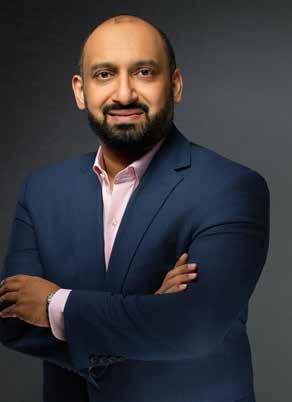
Sabir Saleem CEO, MBUZZ
As enterprises in the region accelerate their AI and cloud strategies, MBUZZ’s integrated offerings position it as a trusted partner for next-generation infrastructure. The company’s strategy centers on building flexible compute platforms that balance performance, scalability, and sustainability, while also aligning with the region’s broader digital transformation and Sovereign AI agendas.
At GITEX Global 2025, MBUZZ aims to demonstrate how its collaborative ecosystem, supported by its technology alliances and integration capabilities, continues to enable innovation across multiple industries. With a forward-looking approach and a growing regional footprint, MBUZZ is strengthening its role as a bridge between cutting-edge technology and practical, deployable enterprise solutions.





Walid Yehia, Managing Director, South Gulf at Dell Technologies, shares how Dell Technologies is enabling organizations to operationalize AI, build resilient infrastructure, and align with regional ambitions for AI-powered growth.
Artificial Intelligence is redefining the very fabric of business and technology. For Dell Technologies, it has become a key theme driving its global and regional strategy. It is positioning itself as the world’s leading provider of AI-centric infrastructure through its comprehensive Dell AI Factory portfolio. The company is delivering end-to-end solutions that simplify and accelerate AI deployment across every environment, from AI-enabled PCs and edge devices to largescale data centers.
“AI is at the core of our strategy, both globally and here in the region. It’s the engine driving the next wave of technological progress and productivity for our customers. We see it as a powerful tool to turn data into intelligent outcomes, faster. Our approach is to make AI accessible for organizations of all sizes. We've broadened our AI ecosystem by delivering a comprehensive, end-to-end portfolio; from AI-enabled PCs and workstations to the world’s most powerful servers, storage, and networking solutions,” says Walid Yehia, Managing Director, Gulf at Dell Technologies.
Among recent product advancements are the Dell Pro Max Plus, a mobile workstation with an enterprise-grade discrete NPU, enabling powerful on-device AI inferencing. In the data center, innovations such as the Dell PowerCool eRDHx cooling system and PowerEdge XE9785 servers with AMD Instinct GPUs enhance energy efficiency and performance for demanding AI workloads. Dell’s AI Data Platform and Project Lightning enable faster, more scalable access to high-quality data, optimizing training and inferencing for large language models.
Dell has deep partnerships with leaders like NVIDIA, ensuring its customers have the validated designs and software stacks needed to accelerate their AI journey and achieve tangible results. Besides NVIVIDA, Dell also has strategic partnerships with other vendors including AMD, Intel, Google, Meta, Mistral, and Cohere, to help its customers with pre-integrated, customizable AI platforms for enterprises

Walid Yehia
Managing Director, South Gulf at Dell Technologies
to build, deploy, and secure AI applications on-premises or in hybrid environments.
With governments and enterprises across the region prioritizing rapid AI adoption, Dell is poised comfortably to be at the forefront in addressing those burgeoning requirements for AI deployments.
Walid says, “We are helping organizations across the region move from AI ambition to reality. Guided by our Dell AI Blueprint, we work closely with governments and public institutions in the region, to help them design and implement a secure, scalable and on-premises AI infrastructure that forms the bedrock of various initiatives.”
Dell sees the end goal as simplifying the entire AI lifecycle.
“We provide the essential infrastructure, high-performance servers, scalable storage, and robust networking needed to build powerful AI models. Through our Dell AI Factory with NVIDIA, we deliver a fully integrated solution that combines Dell infrastructure with NVIDIA's advanced AI enterprise software and accelerated computing,” says Walid.
This collaboration offers customers pre-validated, full-stack solutions that streamline deployment, efficiently manage data pipelines, and accelerate time to value for their AI projects, from pilot to production.
Edge computing is emerging as one of the most critical enablers of real-time AI. Dell is collaborating with telecom operators and enterprises to ensure that AI intelligence extends seamlessly to the edge.
“Our focus is on co-creating solutions that bring AI processing closer to where data is generated. By combining our robust edge hardware and software with the power of 5G and private wireless networks, we enable real-time insights for industries like manufacturing, retail, and smart cities. We are helping organizations deploy AI-ready edge platforms that can handle demanding workloads, ensuring low latency and high performance for use cases from industrial automation to enhanced customer experiences,” says Walid.
AI is also reshaping the endpoint experience. From PCs to workstations, Dell’s AI-enabled devices are designed to boost performance, security, and creativity.
“The response to our AI-enabled PCs and workstations in the region has been extremely positive. We are seeing strong demand across all user segments, from commercial clients looking to boost employee productivity to creative professionals who require immense processing power for complex tasks,” says Walid.
The integration of neural processing units (NPUs) into Dell’s devices is transforming the user experience, enabling new levels of performance, security, and battery life.
He adds, “For data scientists and engineers, our products remain the top choice, providing the power needed to develop and run sophisticated AI models locally. This adoption underscores the
tangible benefits AI brings to everyday work.”
As organizations look to harness large language models (LLMs) securely, Dell is focused on giving them flexibility and control. The Dell Validated Design for Generative AI with NVIDIA provides a pre-tested blueprint for building and fine-tuning models on-premises or in a hybrid environment.
Walid says, “This gives our customers in the region the flexibility to innovate with their proprietary data while addressing critical requirements for data sovereignty, security, and compliance. By providing the essential infrastructure and a clear framework, we help businesses build their own generative AI solutions that are tailored to their specific needs, reducing complexity and accelerating their path to production.”
Dell Technologies is closely aligned with national AI visions, particularly in the UAE. Walid emphasizes that the company’s role goes beyond technology delivery.
“We are deeply committed to supporting the ambitious national AI strategies of governments across the region, specifically the UAE. Our participation extends beyond technology; we are actively involved in building a future-ready workforce through skills development programs and collaborations with academic institutions. We partner with public sector entities on pilot projects and provide expertise to help build sovereign AI capabilities.”
He says that building a national AI capability is a monumental task that no single entity, government or private company, can achieve alone. Here, public-private partnerships are the engine for turning ambition into reality.
“Governments provide the vision, the national priorities, and the regulatory leadership and companies, like Dell, bring the technology, the global expertise, and the agility to innovate quickly. Similarly, by investing in local talent and providing access to our global expertise and AI infrastructure, we are helping governments accelerate their digital transformation agendas and establish themselves as leading AI-powered economies on the world stage.”
In the UAE, for instance, Dell joined forces with the UAE Ministry of AI, alongside the National Program for Artificial Intelligence and the National Program for Coders, to launch the UAE AI Camp.
In an AI-driven world, security must evolve just as quickly. Dell is embedding AI across its security architecture to help organizations stay resilient.
Walid says, “Security is paramount in the AI era, and we are embedding AI-driven intelligence across our security portfolio to protect our customers from endpoint to cloud. Our approach uses machine learning to proactively detect and respond to threats faster than ever before. For example, our endpoint security solutions use AI to identify anomalous behavior and stop sophisticated malware before it can cause damage.”

At the infrastructure level, Dell is integrating AI to monitor for threats and automate recovery processes, building a more resilient foundation. This helps organizations in the region strengthen their security posture and confidently innovate, knowing their data and operations are protected.
Sustainability remains a key pillar of Dell’s global and regional vision and AI plays a crucial role in achieving it.
“We support enterprises and public sector customers across the region in modernising infrastructure to reduce power costs while scaling AI. We use AI to design more energy-efficient products and to optimize cooling and power consumption in data centers, directly reducing their carbon footprint. For instance, our smart cooling innovations like the industry-first Dell PowerCool Enclosed Rear Door Heat Exchanger (eRDHx) is a Dell-engineered alternative to standard rear door heat exchangers. Designed to capture 100% of IT heat generated with its self-contained airflow system, the eRDHx can reduce cooling energy costs by up to 60% compared to currently available solutions.”
Dell’s work in circular design is also supported by data analytics, helping the company use more sustainable materials and design products that are easier to repair, reuse, and recycle. Dell also empowers its customers in the region with tools and solutions that provide greater visibility into their energy use, helping them achieve their own sustainability goals.
At GITEX 2025, Dell will spotlight the future of the autonomous enterprise, showcasing a new era where organizations harness the power of Agentic AI and the Dell Automation Platform to operate with greater speed, intelligence and resilience.
Walid says, “Unlike traditional AI that relies on frequent human intervention, Agentic AI can independently refine processes in real time, guided by enterprise data and goals. Combined with the Dell Automation Platform and the Dell AI Factory with NVIDIA, we’re giving businesses the tools to seamlessly embed intelligent automation into their workflows, infrastructure and data ecosystems, to unlock higher levels of productivity, agility and innovation.”
An immersive 4D experience will bring this vision to life, where visitors at GITEX can explore the Dell AI Factory and its latest AI-powered PCs. Alongside these innovations, Dell will show-
case the full breadth of its portfolio, from client and infrastructure solutions to multicloud, security and services, all designed to help organizations not only accelerate their AI journeys but also prepare for what’s next.
Looking to the future, Dell Technologies remains focused on being the region’s most trusted transformation partner.
“Our primary objective is to be the most trusted technology partner for businesses on their digital and AI transformation journeys. We will continue to invest heavily in our local teams, partnerships, and channel ecosystem to bring our global innovations closer to our customers.”
A key focus for the company will be enabling the widespread adoption of AI by providing simplified, end-to-end solutions that deliver real business outcomes.
“We are also committed to supporting national visions for economic diversification and talent development, empowering the public and private sectors to innovate with confidence, security, and a commitment to sustainable progress. Additionally, we will continue to focus on sustainability, embedding green technologies into our end-to-end solutions while supporting the region’s broader goals.”
As AI continues to reshape industries and redefine possibilities, Dell Technologies stands at the intersection of innovation and execution. Through its strategic industry partnerships, end-to-end infrastructure, and strong regional collaborations, the company is helping organizations across the region transform their AI ambitions into measurable outcomes.



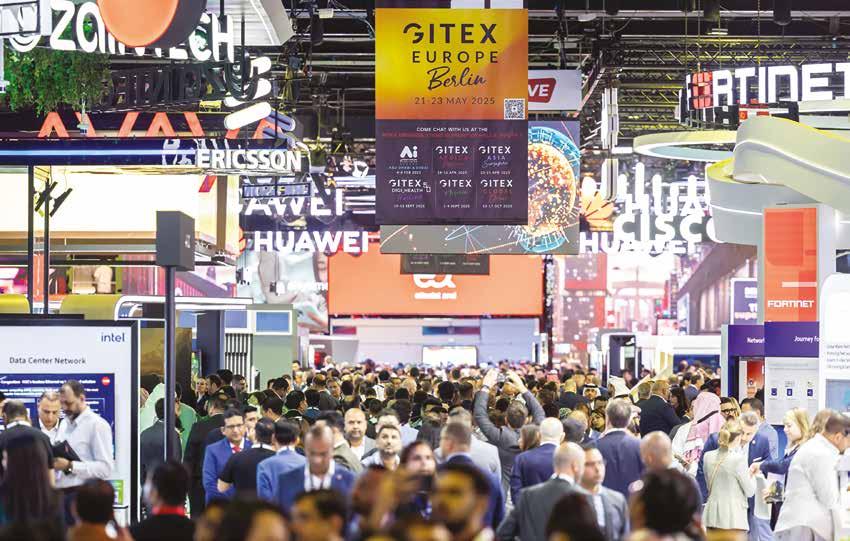

In this conversation, Praneeth V, Technical Evangelist at ManageEngine, discusses the company’s latest advancements in GenAI, endpoint autonomy, identity security, and MSP enablement — all designed to help enterprises manage hybrid environments with greater efficiency, security, and intelligence.

Praneeth V Technical Evangelist, ManageEngine
What are the major highlights for ManageEngine at this year’s GITEX?
At GITEX Global 2025, ManageEngine will showcase its integrated solutions designed for secure and efficient IT management for hybrid environments. The spotlight will be on integrated solutions spanning ITSM, SIEM, IAM, UEBA capabilities, anchored by the latest updates to Log360 and ServiceDesk Plus. The new updates in Log360 include re-engineered detection, a multi-tiered enterprise architecture, and 1,500+ prebuilt and cloud-delivered detection rules that reduce false positives, ensure up-to-date threat coverage, and scale to meet enterprise demands. On the other hand, ServiceDesk Plus' Ask Zia, the virtual agent, now offers contextual, conversational assistance and workflow automation, enabling IT teams to resolve issues faster and smarter. ManageEngine’s cybersecurity experts will be available at Hall 25, B10 for live demos and consultations.
With your latest GenAI release in ServiceDesk Plus, how will offering a choice between Zia LLM and public AI providers like ChatGPT and Azure OpenAI, impact adoption, cost optimization, and enterprise trust?
In ServiceDesk Plus, every GenAI capability can be powered by one among three AI providers - Zia LLM, OpenAI ChatGPT, and Azure OpenAI. Zia LLM, the proprietary LLM of Zoho Corporation— powered by open-source foundational models, is currently offered at no additional cost, enabling customers to eliminate the unpredictability of pay-per-token pricing common with public LLMs, ensuring stable costs and simplified deployment.
Enterprises with existing enterprise licenses for public LLM service providers can leverage their preferred LLMs to power up a subset of capabilities. This hybrid approach helps them rationalize token consumption and conserve the use of leading-edge LLMs for specific GenAI capabilities in ServiceDesk Plus that deliver the maximal ROI and business outcomes.
With the addition of DEX capabilities in Endpoint Central, how does ManageEngine’s approach to autonomous endpoint management differ from other UEM vendors in the market? With the introduction of Digital Employee Experience (DEX) capabilities, ManageEngine goes beyond traditional UEM automation by making endpoint management experience-driven and self-healing. Endpoint Central combines real-time telemetry, root-cause analysis, and no-code remediation workflows to automatically detect, understand and resolve issues proactively. This context-aware automation closes the loop between visibility, insight, and action, reducing tickets, cutting downtime, and improving user satisfaction.
Unlike solutions that treat experience management as an add-on, ManageEngine embeds DEX natively into endpoint operations, enabling IT to transition from reactive device management to proactive, autonomous endpoint operations that optimize performance and employee productivity.
Highlight how endpoint central helps achieve operations efficiency, savings, enhanced security and compliance requirements?
Endpoint Central boosts operational efficiency by unifying device provisioning, security, patching, software deployment, remote troubleshooting, and threat management into a single unified console. Its centralized visibility and intelligent automation reduce costs and manual work, with pre-built workflows, no-code custom actions, and extensive script libraries. Integrations with ITSM, vulnerability tools, and platforms like Zoho Flow enable seamless cross-solution orchestration.

Its robust security stack includes NGAV, ransomware protection, vulnerability management, device control, and browser protection, defending against evolving threats. Compliance is ensured through policy enforcement, audit-ready reports, and 75+ CIS benchmark templates. Non-compliant devices are quickly quarantined and remediated. Altogether, Endpoint Central streamlines operations enhance security, reduce costs, and ensures continuous compliance via a single integrated platform.
With identity cited as the primary attack vector in breaches, how do the new identity risk exposure management and local user MFA features differentiate AD360 from traditional IAM?
With identity emerging as the primary attack vector in modern breaches, ManageEngine AD360 extends beyond traditional IAM to deliver seamless identity defense by embedding risk intelligence into everyday operations.
The recently introduced Risk Exposure Management capability continuously analyzes privilege relationships, attack paths, and exposure patterns, to highlight exploitable identity risks and provide actionable guidance to strengthen identity security posture.
The Local User MFA feature extends protection to unmanaged local accounts and endpoints, bringing them under centralized visibility and control. This helps organization’s close identity silos and reduce the attack surface that often arises when local identities remain outside centralized management.
Together, these capabilities position AD360 as an active identity defense system that safeguards identities across hybrid environments.
How does MSP Central’s modular, multi-tenant design help service providers eliminate tool sprawl and improve technician efficiency?
MSP Central was designed to eliminate tool sprawl by providing a truly multi-tenant platform, purpose-built for managed service
providers. Its architecture isolates customer data from the user interface to the backend, ensuring complete autonomy and protection, while maintaining minimal and secure access for daily operations. This design extends across all integrated solutions within the platform, including PSA, RMM, and Endpoint Security—enabling smooth data flow and better service context. As MSP Central expands to include capabilities like SIEM, MSPs can expect fewer tool transitions, greater operational visibility, and faster SLA fulfillment, enabling technicians to focus more on outcomes.
"Endpoint Central combines real-time telemetry, root-cause analysis, and no-code remediation workflows to automatically detect, understand and resolve issues proactively. This context-aware automation closes the loop between visibility, insight, and action, reducing tickets, cutting downtime, and improving user satisfaction. "
ManageEngine unveils Generative AI release for ServiceDesk Plus
ManageEngine has announced a major GenAI release in the cloud version of its unified service management platform, ServiceDesk Plus, to transform service experiences and foster greater productivity levels for end users, technicians, and process owners.
ManageEngine's AI strategy for ServiceDesk Plus revolves around providing customers with the flexibility to choose the AI providers of their choice for various AI capabilities. Customers can leverage Zia LLM without any additional pay-per-usage costs or choose between public AI providers like ChatGPT and Azure OpenAI. The company believes that this approach helps customers leverage the best model suitable for various AI functionalities while also optimizing the costs involved.
AI-powered ITSM for ServiceDesk Plus
ManageEngine's customers benefit from the breadth and depth of AI-driven ITSM capabilities across editions, without any additional
licensing complexity. The latest update to the cloud version of ServiceDesk Plus includes a host of AI features, including:
• Ask Zia: Now sporting an LLM-style interface with multi-modal support, the GenAI-powered Ask Zia virtual agent empowers end users, technicians, and process owners to accomplish their goals conversationally. It delivers answers instantly, searches across the service desk, extracts and summarizes KB articles, and performs ticketing action functioning as the primary touchpoint for every persona.
• Ask Zia Workflow Assist: Acting as a personal workflow expert, it helps process owners move from theoretical blueprints to fullfledged workflows in seconds. Workflow Assist understands descriptive requirements and images and generates visual workflows with suggestions for automation, condition checks, and fixing disconnected nodes.
• Other GenAI enhancements: Leverage the ability to generate resolutions from ticket conversations, notes, and past tickets; create checklists; generate custom JavaScript snippets for template customizations; and recommend solutions when users create or edit tickets.

Sayantan Dev, Global Head, Software Solutions Group (SSG) at Redington Group, shares how the new business unit is accelerating Redington’s evolution toward subscription-led, service-driven growth, while enabling partners to modernize confidently and unlock new opportunities in the AI and cloud era.
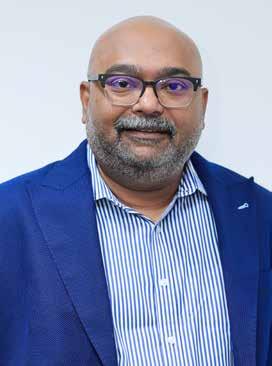
Redington recently unveiled the Software Solutions Group (SSG), a dedicated business unit that brings together the company’s cloud, software, and security portfolios under one unified structure. The move reflects Redington’s strategic response to the industry’s ongoing shift toward cloud-first, subscription-based, and service-led business models.
The goal is to accelerate Redington’s presence in high-value, non-physical, and recurring revenue streams, while driving a broader organizational transformation to become more agile, capability-driven, and digitally enabled.
“It’s about sharpening our local execution, building deeper partnerships, and making decisions faster so we can stay ahead of the curve,” says Sayantan Dev, Global Head, Software Solutions Group (SSG) at Redington Group.
The group is designed with some clear strategic priorities.
“First, we’re moving toward subscription-led growth by focusing on scalable, digital-first offerings, whether that’s SaaS, IaaS, or PaaS. To support this, SSG has a global-regional structure. The global team drives strategy, alliances, engineering, and marketing, while regional business units focus on execution and partner enablement across MEA, India, ASEAN, and Turkey.”
Building on this unified strategy, Redington is bringing its new vision to life at GITEX Global 2025, where it will be showcasing their partnerships with global software vendors and actively seek to expand partner ecosystem, including onboarding ISVs and startups through dedicated programs.
“We’re also talking about CodeHive –Stacked by Redington, our AI user group community built for people who are already using AI in their businesses. It’s a space to connect with like-minded professionals, exchange ideas, and explore new ways to put AI into action. We aim to have similar user groups across cybersecurity and DevOps,” says Sayantan.
Service-Led Models
According to Sayantan, the shift to cloudfirst, subscription-based, and service-led models is not just inevitable, rather it’s already here.
“For many of our partners, the real challenge isn’t deciding whether to evolve; it’s figuring out how to make that transition without disrupting what’s already working.”
Through SSG, Redington is helping partners modernize at their own pace, guiding them from transactional selling to value-led, services-driven models. This, Sayantan explains, is at the heart of Redington’s mission to ‘Unlock Next’, enabling partners to evolve confidently while preserving business momentum.
Redington has built the infrastructure, tools, and credit systems to make that possible, and has simplified a very complex ecosystem so partners can focus on what matters more: building solutions, nurturing custom-
er relationships, and growing sustainably. “What SSG really does is remove the friction,” Sayantan elaborates. “It unifies multi-vendor cloud, AI, and cybersecurity offerings under one umbrella, automates billing and lifecycle management, and gives partners a clear view of profitability and opportunity.”
CloudQuarks: Simplifying the MultiCloud Journey
Another major highlight within SSG’s portfolio is CloudQuarks, Redington’s unified multi-vendor cloud marketplace that simplifies how partners transact, manage, and scale their cloud businesses.
“Unlike traditional marketplaces, CloudQuarks combines commerce, automation, and enablement within a single ecosystem,” adds Sayantan.
Through a self-service portal, partners can manage subscriptions, billing, and renewals across multiple vendors with full visibility and control. Built-in tools for credit management, analytics, and lifecycle oversight help partners optimize cash flow, uncover new opportunities, and enhance profitability.
On the ground, CloudQuarks delivers simplified multi-cloud management, automated provisioning, and consolidated billing, helping partners go to market faster and operate more efficiently. “We’re already working on the next-generation version of CloudQuarks, built to deliver even greater intelligence, automation, and scalability for our partners,” Sayantan adds.
Bridging the Skills Gap Through Redington Academy
Skills remain a major challenge in areas like cybersecurity, AI, and analytics, and Redington is addressing this gap through Redington Academy and its specialized practices.
“Through Redington Academy and our specialized practices in security, analytics, and AI, we’re investing in the skills, tools, and frameworks that empower our teams and partners to deliver meaningful value in a digital-first world,” says Sayantan.

At GITEX 2025, the conversation is likely to move beyond pilot projects and proof-of-concepts to a more mature discussion around execution, scalability, and measurable value. Regional enterprises are no longer asking if they should embrace AI, automation, or cloud but how fast and how securely they can do it.
A new consensus is emerging that the real transformation lies at the intersection of AI, cybersecurity, data, and infrastructure. This is a convergence that is building the foundation of tomorrow’s intelligent enterprises.
Artificial intelligence has rapidly become the beating heart of modern cyber defense and IT operations. Ezzeldin Hussein, Regional Senior Director, Solution Engineering at SentinelOne, says the shift is both cultural and architectural.
“At GITEX GLOBAL, we’re showcasing how SentinelOne is transforming cybersecurity through the power of AI under the show’s theme ‘Securing the Future with AI-Powered Cyber Defense.’ The key focus is on demonstrating how enterprises and governments can move from reactive defense to autonomous, AI-driven security operations.”
The company’s Singularity Platform integrates visibility, detection, and automated response across endpoints, cloud, and identities. Its star attraction, Purple AI, acts as an agentic AI analyst that can reason through incidents, triage alerts, and guide security teams with natural-language insights.
“With AI-SIEM and Hyperautomation, we’re redefining the SOC model by combining high-speed analytics, intelligent automation, and adaptive workflows for real-time decision-making,” Ezzeldin adds.
This same principle of predictive intelligence is transforming IT operations as well. Salman Ali, Senior Manager – Solution Engineering, GCC at Riverbed Technology, believes AI has matured from reactive diagnostics to proactive orchestration.
“This year at GITEX, we’re showcasing one of Riverbed’s most significant innovation cycles in nearly a decade, centred on AI-powered AIOps, observability, and acceleration solutions.

Ezzeldin Hussein
Regional Senior Director, Solution Engineering, SentinelOne
These are designed to help enterprises anticipate and prevent IT issues before they occur, optimise digital experiences, and reduce operational costs. In a region where digital transformation is advancing rapidly, our solutions deliver predictive insights, automate remediation, and consolidate toolsets, giving IT teams the clarity, speed, and resilience they need to thrive in complex, hybrid environments.”
Both leaders see the Middle East as an early adopter of autonomous IT.
“Our AI-native approach transforms security operations by embedding intelligence across every layer of the Singularity Platform. Using advanced behavioral AI, we detect anomalies in real time, correlate massive datasets, and automate responses even before human intervention is required,” notes Ezzeldin.
Riverbed’s observability platform now uses GenAI to interpret telemetry across networks, applications, and endpoints, allowing customers to ask natural language questions and receive actionable, explainable insights.
Salman adds, “Early adopters are seeing measurable benefits from faster issue resolution and tool consolidation to significant reductions in mean time to repair. Looking ahead, we’re exploring Agentic AI to move from insight to automated action. By starting with narrowly scoped agents and strong guardrails, we’re ensuring these solutions deliver trustworthy automation and tangible business impact.
Whether in the SOC or NOC, enterprises are embracing the same vision to move from reaction to prevention, from detection to prediction, a shift that defines the new operating rhythm of digital resilience.
Yet behind every AI breakthrough lies a simple truth, and it is that no AI is better than the data that feeds it.
Yasser Shawky, Vice President, Emerging Markets (MEA) at Informatica, calls 2025 a turning point.
“2025 has been a reality check for AI. With 95% of pilots reportedly failing, organisations are realising that the real challenge isn’t the algorithms but rather the data powering them. At GITEX, we’re spotlighting the difference between high-quality data and AI-ready data.”
Informatica’s Intelligent Data Management Cloud and its CLAIRE AI engine help enterprises convert fragmented, inconsistent data into a trusted, unified foundation.
“Agentic AI is redefining how enterprises manage, govern, and scale data. At Informatica, we’re embedding it across our portfolio, including in data governance, to act as an intelligent layer overseeing the entire data estate. This means automated discovery, real-time compliance enforcement, and quality assurance, which frees teams to innovate faster and more securely”
Maher Jadallah, Vice President, Middle East & North Africa at Tenable highlights the critical need to secure national digital agendas that focus on significant digital transformation initiatives, which in turn end up creating fragmented attack surfaces.
“At GITEX Global, Tenable is spotlighting the necessity of Exposure Management as the core theme. The organization is showcasing its AI-powered Tenable One Exposure Management Platform to address the critical priority of securing national digital agendas like Dubai's D33 and Saudi Vision 2030. These initiatives rely on massive digital transformation, which simultaneously creates a fragmented attack surface. Tenable's innovation directly addresses this fragmentation by providing a unified view across IT, Cloud, OT, and Identities, enabling enterprises to move from simply discovering weaknesses to strategically eliminating the exposures that threaten their most ambitious "smart city" and economic diversification goals.”

Ali Senior Manager – Solution Engineering, GCC,
"Early adopters are seeing measurable benefits from faster issue resolution and tool consolidation to significant reductions in mean time to repair. Looking ahead, we’re exploring Agentic AI to move from insight to automated action."
He explains that Tenable’s AI Exposure Engine translates technical vulnerabilities into business context.
“It pinpoints the 1–2 percent of exposures that are truly critical,” Maher notes. “That allows CISOs to align cybersecurity decisions directly with business outcomes.”
Both Yasser and Maher believe the region is moving from experimentation to disciplined execution.
“The Middle East is no longer following global trends — it’s shaping them,” Yasser remarks. “Governments and enterprises are investing heavily in AI, cloud modernization, and data governance as national imperatives.”
Maher adds, “Resilient investment is now viewed as the insurance premium for protecting national digital ambitions.”
These perspectives underline a growing realization that data governance, AI, and security are now a continuum, not separate.
The AI revolution is also hardware-focused. As compute-intensive workloads grow, the infrastructure itself must become smarter. Joseph John, Regional Manager for HOT Systems at Omnix International, believes performance, scalability, and sustainability can coexist.
Joseph says, “At GITEX this year, HOT Systems is showcasing innovations in High-Performance Computing (HPC) and Hardware-Software Co-Optimization, featuring systems optimized

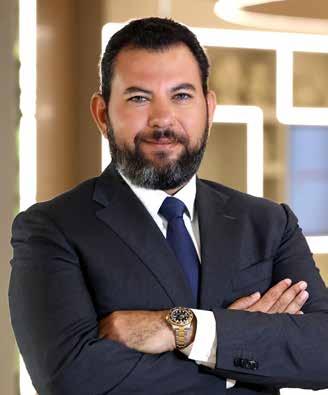
Yasser Shawky Vice President, Emerging Markets (MEA), Informatica
Maher Jadallah Vice President, Middle East & North Africa, Tenable
for compute-intensive workloads through its proprietary HOTHardware Optimization Technology, delivering up to 33% higher performance. The company emphasizes balanced, reliable, and scalable systems supported by 24/7 local service and redundancy for critical workflows. This approach enhances cost efficiency by optimizing performance per unit cost, reducing energy use and total ownership costs”
The company’s AI + HPC fusion enables customers to train, simulate, and visualise on a single platform.
“HOT Systems embeds AI, Generative AI, and Agentic AI directly into the DNA of its hardware solutions, not just as buzzwords, but as tangible enablers of productivity, speed, and innovation. Customers across AEC, research, and enterprises are already experiencing faster time-to-market, lower costs, and new creative possibilities powered by HOT Systems, ” he explains.
For Joseph, the regional momentum is unmistakable. He believes that while national strategies such as the UAE’s Digital Economy Strategy and Saudi Arabia’s Vision 2030 are decisively driving the momentum, there is a lot of growth in the private sector as well.
“Regional technology investment is accelerating, driven by strong government initiatives like the UAE’s Digital Economy Strategy and Saudi Arabia’s Vision 2030, which prioritize AI, data centres, and digital infrastructure. The private sector and startups are also fuelling growth across fintech, health tech, and green tech, supported by rising VC interest. Emerging technologies such as AI, GenAI, IoT, and AR/VR are seeing real-world deployment, while sustainability and energy efficiency are shaping investment priorities. With robust infrastructure and regulatory incentives,

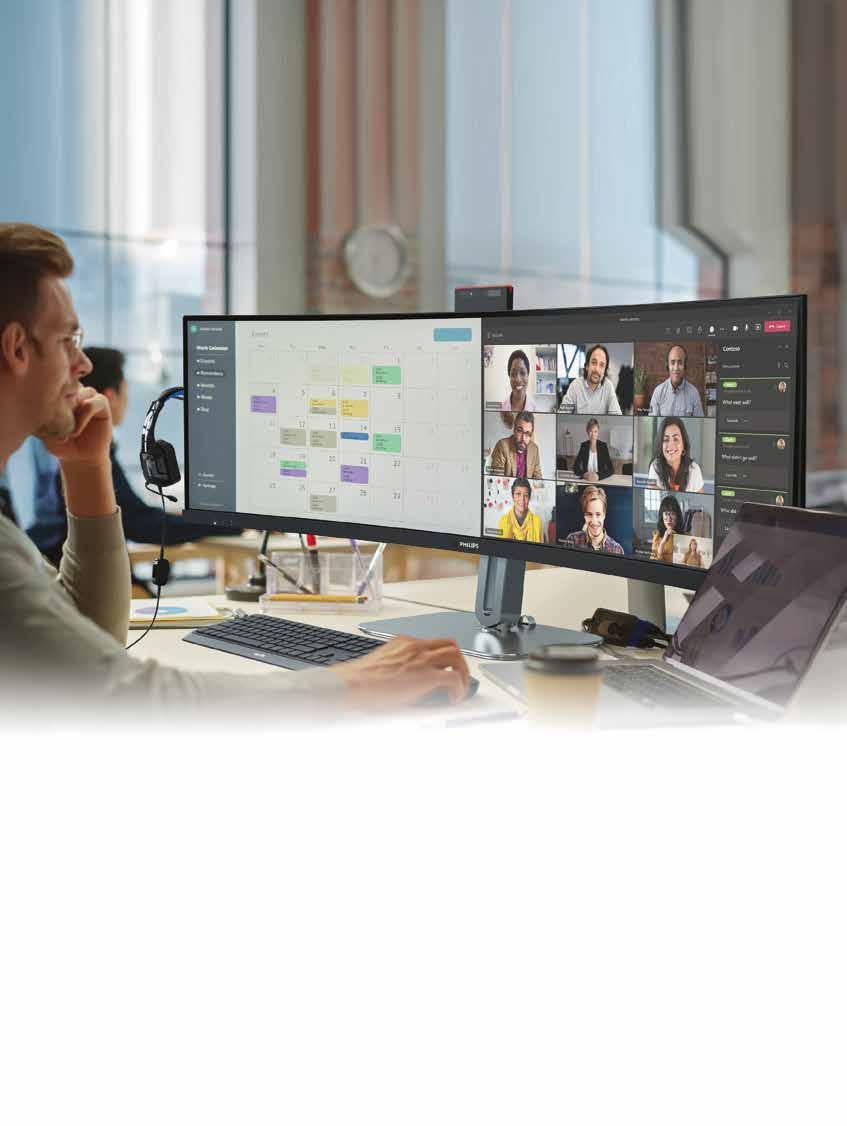




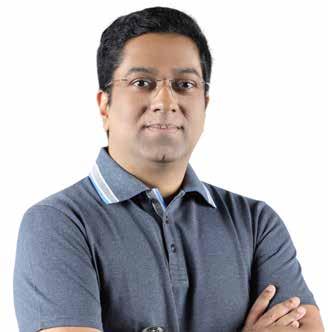
the region is primed for transformation. HOT Systems is ideally positioned with its AI-optimized, energy-efficient hardware to serve this surge in demand across enterprise, research, and smart city sectors.”
Infrastructure intelligence is thus fast becoming the third pillar of transformation, complementing data integrity and security automation to create a truly autonomous enterprise architecture.
As the digital landscape grows, so does its attack surface. The regional cybersecurity dialogue has shifted from compliance to continuous exposure management.
Ezzeldin of SentinelOne observes that threats now evolve faster than human response cycles can manage.
“Traditional, rule-based security models can no longer keep pace with the scale, sophistication, and speed of today’s threats. Our AI-native approach transforms security operations by embedding intelligence across every layer of the Singularity Platform. Using advanced behavioral AI, we detect anomalies in real time, correlate massive datasets, and automate responses even before human intervention is required.”
Maher of Tenable adds that protecting the convergence of IT and OT is now a national priority.
“Investment sentiment in the Middle East is rapidly evolving, driven by the realization that cyber risk is foundational to economic resilience. There is a decisive shift toward strengthening defenses in three critical areas: Cloud Security, Critical Infrastructure (OT), and AI Adoption. Organizations are moving away from siloed tools towards integrated solutions that can secure these expanding domains holistically. The heightened focus on projects like D33 and Vision 2030 mandates this investment, as
the convergence of IT and OT in smart infrastructure elevates the cost of downtime.”
Ezzeldin emphasizes that AI itself must be secured.
“In the Middle East, we can see a major shift in the way organizations approach cybersecurity investments. The focus has shifted from reactive protection to proactive resilience driven by the rapid adoption of cloud, AI, and critical infrastructure digitization. Governments and enterprises are prioritizing sovereign cloud strategies, zero-trust architectures, and AI-powered automation to secure large-scale, interconnected environments. Investments are increasingly directed toward platforms that provide full visibility, data-driven insights, and autonomous response across endpoints, cloud workloads, and identities. The demand for securing AI itself has also grown, as organizations adopt generative and agentic AI tools that require runtime protection and governance. In critical infrastructure, the emphasis is on operational continuity, which means ensuring systems can withstand and recover from sophisticated, nation-state-grade attacks.”
Across vendors and verticals, optimism runs high. 2025 could well be “the year of measurable AI.”
Riverbed’s Salman says, “The regional sentiment is highly positive and organisations are moving from AI ambition to action. Our latest research shows enterprises have signficiantly increased their AI investments year-on-year, with most reporting strong ROI from AIOps initiatives. Enterprises are shifting focus from experimentation to scale, investing in technologies that improve visibility, automate workflows, and enhance user experience. This signals a maturing approach to technology investment that is rooted in measurable outcomes and long-term operational efficiency.”
Yasser sees the same pattern in the data domain.
“Looking ahead, 2026 will be the year of tangible results, as organisations that built the right data foundations begin to showcase real, scalable AI value.”
Meanwhile, Joseph John is preparing for a hardware renaissance. “Looking ahead, HOT Systems plans to expand into AI, generative AI, and edge computing, focusing on sustainability, energy-efficient cooling, and regional service excellence to support growth in high-performance computing and digital transformation sectors. Geographically, it is looking at entering other markets such as India, Singapore, Malaysia and Indonesia, and into new verticals,”
The takeaway from these perspectives seems to be that there is unmistakable convergence across AI, cybersecurity, data, and infrastructure. The next competitive edge will come from how effectively organizations can connect the dots, merging AI with security, data with trust, and infrastructure with sustainability. The future belongs to those who can turn intelligence into resilience and resilience into transformation.





Jishanth Karunakaran, CEO of Mindfire Technologies LLC, outlines the company’s strategy centered on human-first innovation, global AI governance alignment, and the expansion of its GenAI-powered cybersecurity model
What are the solutions that Mindfire is showcasing at GITEX?
At GITEX Global 2025, Mindfire Technologies LLC is unveiling its groundbreaking GenAI-powered proactive operations model under the tagline #GenAISoul: Hunt with AI, Heal with Heart, spotlighting human-first security innovation in partnership with LevelBlue, IBM Security, CrowdStrike, Proofpoint, Exterro, Wiz, Microsoft, Fortra, Cyble, Swiss GRC, Acronis, FourCore, Microsec, CyberArk, Hwacx, KeyStrike, and Konnectify.
In an era where technology must blend innovation with empathy, Mindfire’s SecOps framework begins with generative AI creating synthetic threat scenarios for predictive foresight, advances to enhanced anomaly detection for real-time vigilance, and culminates in orchestrated responses that preempt risks such as AI-driven phishing and polymorphic malware. Human analysts guide these interpretations, validate AI outputs for bias, and infuse ethical judgment, ensuring that outcomes remain trustworthy and aligned with human intent.
Key highlights include passwordless and risk-based access using GenAI-crafted FIDO2 passkeys and biometrics that cut phishing risk by 99% through liveness verification; GRC automation simulating audits and dashboards under the EU AI Act and NIST RMF, reducing preparation time by 59%; and agentic AI for intelligent threat triage and hyper-realistic simulations with human-in-theloop safeguards.
Other innovations include predictive threat intelligence for logical attack forecasting, intelligent vulnerability management, and Konnectify for AI-automated workflows correlating exposures, attack surfaces, data security, lateral movement prevention, and breach simulations. Visitors can experience interactive demos and join the session “#GenAISoul: Pioneering Empathetic, Proactive Defense” on October 15 to explore these resilient innovations in action.
How do you see the growing impact of AI in cybersecurity?
AI’s impact in 2025 follows a dual-path trajectory. On one side, adversaries are exploiting generative AI for deepfake phishing and polymorphic malware, accelerating deception and automating evasion tactics. On the other, ethical AI deployment, beginning with clean data ingestion, advancing to real-time analysis, and culminating in automated, human-supervised responses, is emerging as a defensive multiplier that reduces breach costs by up to 46%.

At Mindfire, our GenAI-powered model under #GenAISoul: Hunt with AI, Heal with Heart embodies human-first resilience. It correlates threat intelligence with vulnerabilities, exposures, and attack surfaces through structured reasoning — starting with the premise of anticipation, guided by ethical correlation, and concluding in proactive defense. This approach tightens identity through passwordless biometrics, strengthens data protection, blocks lateral movements, and validates breach simulations with human oversight — ensuring security that protects both systems and people.
With 66% of organizations acknowledging AI’s dual role, the future depends on strong AI governance to mitigate bias, ensure transparency, and contain adversarial misuse.
What are the most significant threat vectors in cybersecurity now?
As of October 2025, global threat vectors have escalated in sophistication. Ransomware remains dominant, with a 46% surge in industrial attacks during H1, exploiting supply chain gaps and polymorphic variants for maximum disruption. This feeds into a surge of AI-enhanced phishing and deepfakes, with over 12.6 million malicious emails detected between January and May. These attacks enable credential stuffing, identity compromise, and adaptive deception.
Compounding this are cloud misconfigurations and hybrid environment exploits, amplified by stolen credentials that facilitate lateral movement and insider risk. At the same time, AI system drift and compliance pressures under evolving regulations such as the EU AI Act increase enterprise exposure.
To counter these threats, Mindfire’s #GenAISoul strategy integrates threat intelligence for correlation, maps exposures to reduce attack surfaces, and deploys synthetic simulations to build human-augmented resilience, forming a multilayered, predictive defense fabric.
What best practices should CISOs be looking at? CISOs should adopt a phased GenAI framework for 2025 SecOps resilience under #GenAISoul: Hunt with AI, Heal with Heart. Begin with the integration of predictive threat intelligence and agentic AI to forecast and triage risks through contextual scoring. Then layer GRC automation for 94% compliance gains and 59% faster audit decisions via real-time monitoring, audit simulation, and shift-left DevOps validation, all aligned with ethical precision per NIST RMF.
Next, implement intelligent vulnerability management for context-driven patching and AI-powered behavioral analytics for early anomaly detection. Culminate in passwordless adoption, a $22B market this year, achieving 99% phishing reduction and 50% support cost savings, enhanced by continuous verification against deepfakes and human oversight.
Finally, strengthen Zero Trust architecture, enforce lateral movement prevention, and conduct hyper-realistic breach simulations. Foster continuous learning, unify CNAPP for hybrid clouds, and measure results for visibility. This holistic approach ensures measurable resilience and compliance with evolving mandates such as DORA and NIS 2.
What have been some significant growth milestones for the company?
Since its founding in 2013 in Dubai, Mindfire’s growth has followed a steady evolution, from IT consulting and cloud/data intelligence for mid-market clients to end-to-end cybersecurity services in advanced threat detection and SecOps.
The company’s 2024 alliance network expanded its managed services with GenAI-driven innovations such as human-first threat intelligence correlation, passwordless integration, and GRC automation, achieving up to 81% reduction in credential breaches and generating $6 million+ in revenue with a team of 59 professionals.
This progression positions us as a cybersecurity leader in the UAE. With the unveiling of the #GenAISoul proactive operations model for resilient finance, government, and enterprise defense at GITEX Global, we look to grow from strength to strength.
What would be some of the key objectives going ahead? Our objectives build logically on human-first innovation — targeting global AI governance benchmarks by delivering GenAI-powered operations that supercharge expertise. The premise is ethical fusion — achieved through structured threat intelligence integration, vulnerability–exposure correlation, attack surface management, and federated learning that enables quantum-resilient collaboration. The logic is proactive layering — culminating in empowered clients who can turn vulnerabilities into strategic advantages.
Mindfire’s GenAI model embodies #GenAISoul: Hunt with AI, Heal with Heart — where generative technologies forge unbreakable security by elevating people and anticipating dangers with the human element. The company aims to expand to over 100 experts within two years, scaling into Africa and Asia with a focus on OT security and forensics. Priority areas include R&D in passwordless and risk-based access, data security, lateral movement prevention, breach simulations, and adaptive controls aligned with NIST RMF. The overarching focus remains on sustainable growth and nurturing specialized talent amid an increasingly complex threat landscape.
"At Mindfire, our GenAI-powered model under #GenAISoul: Hunt with AI, Heal with Heart embodies human-first resilience. It correlates threat intelligence with vulnerabilities, exposures, and attack surfaces through structured reasoning — starting with the premise of anticipation, guided by ethical correlation, and concluding in proactive defense"
Regional CXOs share how AI, cloud, and cybersecurity are converging to reshape enterprise strategy

ADr. Shijin Prasad
Group IT Head, Elyzee
Healthcare Group, UAE & KSA
cross the Gulf, technology leaders are steering their organizations into an era where artificial intelligence, cybersecurity, and cloud convergence define digital maturity. The next 12 to 18 months promise a phase of accelerated innovation, one that demands agility, ethical alignment, and operational resilience.
Across industries, CXOs are prioritizing AI-driven operations, cybersecurity modernization, and integrated data ecosystems. For Dr. Shijin Prasad, Group IT Head at Elyzee Healthcare Group, UAE & KSA, the focus is firmly on building an AI-driven, compliant, and patient-centric healthcare ecosystem.
He explains, “The healthcare sector is undergoing a rapid digital transformation, and our technology roadmap for the next 12–18 months focuses on building an AI-driven, compliant, and patient-centric ecosystem.”
His priorities include AI-enabled cybersecurity and compliance automation, where an AI Cybersecurity Framework will continuously monitor regulatory posture and automate incident response, as well as next-generation HIS–ERP integration to unify patient care, finance, and analytics. He adds, “By embedding AI in capacity forecasting, equipment maintenance, and clinical documentation, we aim to improve hospital efficiency and resource allocation, reducing manual dependencies while ensuring traceable audit trails.”
In the engineering and infrastructure space, Damir Jaksic, CIO and Executive Director Digital Advisory Services at KEO International Consultants sees AI and data integration as twin engines of growth. “Key priorities include scaling our AI and data-driven decision platforms, such as chat.keo.com, and strengthening cybersecurity resilience, technically and governance wise. We’re also driving greater integration across BIM, digital twins, and smart asset management to enhance project intelligence and client value in our Digital Advisory Services.”
Anchal Choubey, Sr Business Transformation leader - private public partnership mega projects, working across public–private partnership ecosystems, emphasizes measurable transformation and cognitive augmentation. “My approach to AI adoption has been deliberately strategic rather than opportunistic. I began by mapping business value chains to identify where machine learning and generative capabilities could create measurable productivity or insight advantages,” he notes. His roadmap now focuses on embedding AI copilots within advisory and project management workflows to boost decision fidelity and operational intelligence.
For Riasat Ali, Group Head of IT at RAK Ports, priorities are grounded in operational transformation. “Digital transformation and innovation, safety, security, AI and automation, OT/IoT-related operations cum security,” he says, revealing a focus that merges modernization with real-time operational intelligence.
With GITEX 2025 on the horizon, CXOs view the platform as an opportunity to explore partnerships and practical AI applications.
For Shijin, the goal is clear: to engage with innovators in Agentic
Damir Jaksic CIO and Executive Director
Digital Advisory Services, KEO International Consultants

AI, systems capable of autonomous decision-making.
“At GITEX 2025, our key objective is to collaborate with AI innovation partners who specialize in Agentic AI — systems capable of autonomous decision-making for operational workflows,” he says. “We are particularly interested in AI companies focusing on Agentic AI for workflow automation and healthcare-focused CRM solutions that integrate with call centers, WhatsApp APIs, and electronic medical records.”
His emphasis is on identifying AI partners who understand compliance sensitivity and the medico-legal framework of the UAE healthcare sector, a hallmark of healthcare digitalization in the region.
Damir echoes that sentiment from a broader industry perspective. “GITEX provides a great opportunity to engage with innovators shaping the next wave of digital disruption. I’m particularly interested in practical AI use-cases, agentic platforms for design automation, and advancements in cybersecurity and cloud orchestration.”
Meanwhile, Riasat views GITEX as a place for exploration and learning. “Primarily to see and explore cutting-edge technologies, networking opportunities, and learning from keynote speakers,” he says.
AI adoption across the region has shifted from experimentation to measurable enterprise impact. For Shijin, AI is already transforming patient engagement and operational intelligence.
“In the aesthetic and wellness segment, where patient engagement and conversion rates are key, our AI adoption strategy is highly focused on Agentic AI for intelligent automation,” he explains. His team is piloting AI modules that analyze lead quality, automate call center follow-ups, and refine marketing strategies. “The measurable impact has been significant — improvement in lead-to-booking conversion rates and a notable reduction in average response time,” he adds.
For Damir, AI has become a creative and analytical force within design and advisory workflows. “We have taken a strategic, value-driven approach — aligning AI initiatives with core business outcomes. Our biggest impact so far has been on using natural language commands and AI workflows to create detailed and artistic visuals, photorealistic images, and renders for our Design Divisions, automating cost estimating workflows, and overall knowledge management,” he says. Embedding generative and analytical AI tools, he notes, has improved design accuracy and reduced rework, an important differentiator for KEO’s clients.
Anchal’s deployment of AI across infrastructure projects demonstrates how public and private sectors can align digital intelligence with societal outcomes. “The first wave of implementation focused on operational intelligence, automating data reconciliation, predictive maintenance, and customer sentiment analytics across infrastructure and public–private partnership portfolios. Now I am moving into cognitive augmentation, embedding AI copilots within project management and advisory workflows to reduce cycle times and enhance decision fidelity,” he explains.
His approach has already yielded measurable results, delivering 25–30% improvement in operational efficiency, faster scenario modeling in feasibility studies, and significant reductions in manual oversight.
At RAK Ports, Riasat takes a pragmatic, operations-first view. “Mainly in operations and supply chain: optimize processes, predict demand, and improve resource allocation. We believe using AI can bring significant cost savings and efficiency gains in areas like stock management and logistics operations,” he says.
Together, their approaches show AI’s transition from concept to operational core — tailored for industry, scale, and measurable return.
As AI becomes central to decision-making, data governance and ethical frameworks have become board-level concerns. For Anchal, governance is not a compliance checkbox but the foundation of responsible intelligence.
“Data governance sits at the center of our AI operating model. We are aligning governance frameworks with ISO 42001 and DAMA-DMBOK principles, ensuring lineage, transparency, and traceability of every dataset used in analytical or generative applications,” he explains. His team has established a cross-functional Data & Ethics Council to ensure fairness and accountability. “As analytics increasingly drive executive decision-making, our north

star is responsible intelligence: systems that are accurate, auditable, and aligned with human oversight.”
He also highlights that in government-facing applications, accountability often outweighs accuracy. “Because government services involve high-stakes decisions affecting citizens' lives, the criteria for model acceptance are often more about accountability, fairness, and trust than purely maximizing a statistical metric.”
Riasat offers a simpler but no less important perspective. “In terms of data governance, we work on data classification and policies around data management. From a quality perspective, we look into data ownership to handle quality, integrity, and usage of data. We understand that ethical use of AI should be fundamental and should be addressed through guardrails of AI policies, bias detection techniques, and human oversight. Decision-making models should be explainable,” he says.
For Damir, ethical enablement is about trust and empowerment. “Our approach is not about constraining AI but about enabling it responsibly — ensuring data integrity, understanding of consequences, and trust — so innovation can scale confidently and ethically across the organization,” he explains.
The consensus across these leaders is clear: ethical AI is not a limitation — it is a strategic enabler for trust, compliance, and enterprise readiness.
As new technologies proliferate, CXOs are becoming increasingly disciplined in evaluating readiness and return.
“We have moved beyond the ‘thousand flowers’ approach of experimenting everywhere to a more formalized and strategic evaluation model,” says Damir. “Our framework balances innovation potential with enterprise readiness — assessing integration effort, compliance implications, and measurable ROI.”
Anchal takes a similarly structured approach. “Our evaluation framework for emerging technologies blends three lenses—strategic fit, enterprise readiness, and scalability economics. We assess generative AI, predictive analytics, and agentic systems not as standalone innovations, but as accelerators within broader business architectures,” he explains. GenAI, he notes, is already creating value by accelerating knowledge management and feasibility study generation, while agentic platforms are being tested for autonomous process orchestration.
Riasat summarizes his evaluation process succinctly. “Key evaluation criteria can be around the answer to the question ‘What business problems does the target technology solve?’” he says.
He adds that key criteria include business value, technical maturity, user experience, data quality, and risk mitigation, a pragmatic lens shared by many enterprise leaders in the region.
As digital ecosystems expand, so do attack surfaces. Regional CXOs are making cybersecurity a continuous, intelligence-driven discipline.
At Elyzee Healthcare, Shijin has made predictive cybersecurity a priority. “As cyber threats evolve, we are taking a proactive AIfirst approach to cybersecurity and data protection. Our ongoing initiative involves building an AI-driven Security & Compliance Dashboard that continuously assesses ADHICS control adherence across infrastructure, applications, and user access points,” he explains. This dashboard not only measures compliance but predicts deviations before they occur, providing a Compliance Health Score benchmarked against UAE healthcare standards.
Damir echoes that AI-driven resilience mindset. “We are investing in adaptive cybersecurity frameworks, and have already integrated zero-trust architecture, continuous monitoring, and employee awareness programs. We have also implemented advanced threat detection and extended protection to our cloud and IoT environments. Cyber resilience is a board-level priority,” he says.
Anchal views cybersecurity as the “steering wheel of enterprise trust.” “Cyber resilience has evolved from being a compliance objective to a core pillar of our digital operating model. With increasing interconnectivity between public infrastructure and private systems, we’ve moved toward a zero-trust architecture reinforced by continuous threat intelligence and AI-driven anomaly detection,” he explains. “I visualize the shifting role of cybersecurity from IT function to enterprise trust fabric as the steering wheel of a racing car — it’s not which car crosses the finish line first, but whether the driver reaches the finish line safely.”
For Riasat, industry standards form the backbone of protection. “We leverage frameworks and standards like ISO 27001 and fol-
Anchal Choubey Sr Business Transformation leader
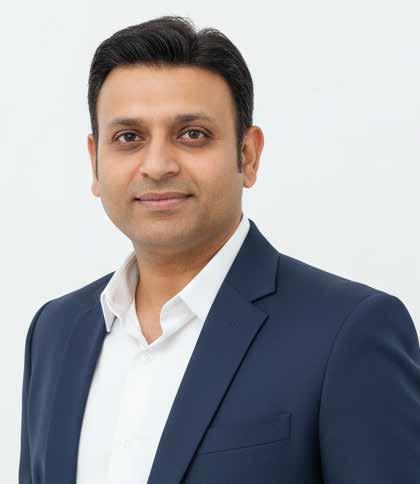
low good industry practices,” he says, adding that fostering a culture of security through awareness and vulnerability management is key to minimizing attack surfaces.
For these CXOs, security is not a layer added after the fact but one that is engineered into every initiative.
“Security is not an afterthought – it is embedded from the first line of code to deployment,” says Damir. “We’ve adopted a Zero Trust mindset, where verification is continuous, access is least privileged, and no user or system is implicitly trusted. Our secure development life cycle includes mandatory threat modelling, code reviews, and third-party audits, which we have completed for our published products.”
Riasat reinforces the same philosophy within industrial and operational environments. “There are multiple initiatives undertaken; however, fostering a culture of security through awareness and training, using vulnerability management, and minimizing attack surfaces are key steps,” he explains.
Together, these perspectives reflect a maturity shift — from compliance-driven security to design-led resilience.
Cloud strategies across the region have matured from lift-andshift to intelligent orchestration.
Damir explains that at KEO, the cloud journey has evolved over a decade. “Our cloud strategy has evolved from basic migration to a hybrid multi-cloud model optimized for flexibility, performance, and compliance a decade back, to a ‘Cloud-First’ approach. ‘Cloud-first is how, not where,’ and it’s not about moving workloads to the cloud — it is a philosophy and architectural approach where cloud capabilities shape every technological decision from the outset,” he says.
Anchal offers a comprehensive perspective shaped by public infrastructure programs. “Our cloud strategy has evolved from a cost-optimization initiative into a deliberate architecture for agility, resilience, and innovation,” he notes. “Today, we operate within a hybrid, multi-cloud framework that balances sovereignty, interoperability, and performance. Core infrastructure and sensitive workloads remain on private or sovereign clouds, while innovation layers run on hyperscale public clouds.”
He adds that the next phase will involve embedding intelligence into the cloud fabric itself — predictive analytics for workload placement, autonomous remediation, and green computing to reduce energy footprints. “In essence, our cloud strategy has moved beyond infrastructure; it’s now the operating system for digital trust and adaptive innovation across our ecosystem.”
At RAK Ports, Riasat takes a measured approach aligned with operational demands. “It’s evolving with technology advancement. A hybrid model is followed,” he says, underscoring the need for flexibility in environments that span IT and OT systems.
As technology leaders across healthcare, engineering, public infrastructure, and logistics align strategy with execution, the pattern that emerges is that AI, cybersecurity, and cloud are no longer parallel priorities. They are converging into a single, intelligent digital backbone that powers operational agility, compliance, and trust.
Shijin puts it aptly, albeit from a healthcare perspective but which holds true for all sectors with reference to the convergence that is happening. He says, “The convergence of AI, cybersecurity, and intelligent automation marks the next frontier of healthcare innovation. As we move toward fully autonomous healthcare ecosystems, collaboration with visionary technology partners and adherence to regulatory excellence will remain our guiding principles. At Elyzee Healthcare, we believe the future of healthcare IT is not just about technology — it’s about trust, intelligence, and transformation.”
That sentiment extends well beyond healthcare. For the region’s CXOs, technology leadership now carries greater responsibility, with security and sustainability emerging as critical pillars in their pursuit to turn their organizations’ digital ambitions into reality.
Sakkeer Hussain, Sales and Marketing Director at D-Link Middle East, discusses the company’s growing focus on mid-market and SMB segments, its leadership in Wi-Fi 7 innovation, and how AI and cloud integration are reshaping the future of connectivity across the region.

Sakkeer Hussain Sales and Marketing Director, D-Link Middle East
Connect platforms, which give small and mid-sized businesses enterprise-grade control without the complexity or cost. From a small café to a multi-branch company, these solutions simplify deployment, monitoring, and troubleshooting — all from a central dashboard, users enjoy self-healing networks that adjust to demand in real time.
We’re also introducing Wi-Fi 7 solutions that future-proof SMB networks, allowing seamless connectivity for smart devices, video conferencing, and digital transactions. In essence, D-Link is helping SMBs operate with enterprise-level confidence, empowering them to grow in an increasingly connected, competitive marketplace.
How successful has Nuclias connect been across some of the different verticals like retail, education, hospitality and others in the region? What have been some of the further features or new functionalities added in Nuclias?
Nuclias Connect has proven to be one of D-Link’s most successful platforms across key sectors such as retail, education, healthcare, and hospitality in the Middle East. It has helped organizations simplify network management, improve uptime, and strengthen security without increasing IT overhead. For schools, it allows seamless management of multiple campuses and student access policies. In retail and hospitality, it enables fast, secure Wi-Fi for both guests and staff — enhancing customer experience while protecting sensitive data.
Discuss your continued focus on the Mid-market and smb segment as a networking solutions provider? What are their expectations as far as connectivity goes and how are you addressing that in the region?
The mid-market and SMB segment continues to be the core focus for D-Link in the Middle East. These businesses form the backbone of the region’s economy, and their connectivity needs are evolving rapidly. Today, SMBs are not just asking for fast Wi-Fi — they’re demanding reliability, security, scalability, and simplicity at a cost that makes sense. Many operate hybrid environments with employees, IoT devices, and cloud applications all competing for bandwidth, so networks need to be intelligent and easy to manage.
D-Link addresses this through our Nuclias Cloud and Nuclias
Over the past year, we’ve rolled out several upgrades, including improved onboarding workflows, and enhanced multi-site management capabilities. Administrators can now visualize network health in real time, manage hundreds of access points remotely, and even automate updates — all from a unified interface.
Nuclias Connect continues to evolve based on customer feedback. Our goal is to make network management as intuitive and efficient as possible for SMBs. With built-in analytics and reporting, it not only powers connectivity but also provides valuable business intelligence that helps organizations make smarter operational decisions.
Highlight some of the Business segment focused new product launches in the recent past?
D-Link has been expanding its business networking portfolio with solutions designed for high performance, scalability, and simplic-
ity. Among the highlights are our Wi-Fi 7 Tri-Band Access Points, AQUILA PRO AI routers, and a new generation of stackable and cloud-managed switches. These products bring enterprise-grade performance within reach for SMBs and growing organizations. The recently introduced DIR-BE981 10G Wi-Fi 7 Mesh System is a standout innovation — built to serve both small businesses and premium home offices. It offers lightning-fast connectivity, intelligent traffic management, and advanced security features. Combined with our new switches and PoE support, it creates a seamless wired and wireless ecosystem that’s easy to scale.
What sets D-Link apart is the integration of AI and cloud management across our devices. Whether it’s optimizing traffic flow, detecting anomalies, or managing multiple sites, our solutions are designed to reduce manual effort while boosting reliability. Each launch reflects D-Link’s vision — making powerful, intelligent networking simple and accessible to every business.
Discuss the focus on wifi 7 in your new products portfolio? How is wifi 7 superior to wifi 6? Wi-Fi 7 is a major focus for D-Link, and we already have Wi-Fi 7 products available in the market. The technology marks a leap forward in wireless innovation, bringing up to 4x faster speeds, ultra-low latency, and improved multi-device performance compared to Wi-Fi 6. For businesses and consumers alike, this translates into smoother 4K/8K streaming, faster data transfers, and better support for IoT and AI-driven applications.
Unlike previous generations, Wi-Fi 7 uses features such as MultiLink Operation (MLO) and 320 MHz channels, which allow multiple data streams to operate simultaneously across different frequency bands. This means less interference, higher throughput, and a more stable connection, even in crowded environments like offices or co-working spaces.
For the region’s SMBs and digital-first households, Wi-Fi 7 ensures that their networks can handle the growing demand of connected devices and cloud workloads. It’s not just an upgrade — it’s a foundation for the future of smart living and digital business.
Elaborate on demand in the stackable switches category? Discuss some of the highlights of recent launches. We’re seeing strong and consistent demand for stackable switches across the region, particularly from education, healthcare, and commercial enterprises. As organizations expand, they need flexible and scalable networking that can grow without major infrastructure changes. D-Link’s latest stackable switch series address exactly that need.
These switches offer high-speed uplinks, PoE support, redundancy, and easy scalability — enabling businesses to expand their networks with confidence. They also come with enhanced security, QoS (Quality of Service), and cloud-based management through Nuclias, giving administrators total control from a single dashboard.
Energy efficiency is another focus area. Our switches are built with smart power-saving technology, reducing consumption
without compromising performance. Combined with user-friendly setup and advanced monitoring tools, these switches simplify complex network environments.
For SMBs upgrading from traditional setups, stackable switches deliver enterprise-grade reliability and performance — allowing them to stay agile, connected, and prepared for the future.
What are the solutions you offer in the surveillance segment for Business customers? Discuss some highlights D-Link has built a strong reputation in IP surveillance solutions for business customers across sectors like retail, education, logistics, and hospitality. Our portfolio includes a full range of IP cameras, NVRs, and cloud-managed monitoring systems that deliver high-quality imaging, reliable storage, and smart analytics. Our latest surveillance lineup focuses on enhancing visibility, efficiency, and ease of use. Features such as motion and sound detection, smart zoning, and instant event notifications allow businesses to respond swiftly to potential incidents.
What sets D-Link apart is our ability to combine connectivity and security in one ecosystem. Whether it’s a retail chain monitoring multiple outlets or a school ensuring student safety, our solutions are built to be easy to deploy, manage, and scale. We focus on giving businesses peace of mind through intelligent, connected surveillance that works seamlessly with their existing infrastructure.
How has D-Link enhanced its products using AI features? AI has become a defining part of D-Link’s innovation journey. Across our product lines, we’re embedding AI-driven intelligence to simplify network management, enhance performance, and deliver more personalized user experiences.
Our AQUILA PRO AI routers automatically analyze network conditions, optimize bandwidth allocation, and reduce dead zones — ensuring seamless Wi-Fi performance across homes and offices. Similarly, Nuclias Cloud leverages AI for predictive maintenance and anomaly detection, allowing networks to self-adjust before issues occur.
For businesses, this translates into lower downtime, faster troubleshooting, and improved user satisfaction. For consumers, it means smoother streaming, smarter parental controls, and stronger security.
How has the company's growth been over the past year in the region? Mention some key objectives for the year ahead. The past year has been very strong for D-Link across the Middle East and Africa. This success stems from our innovation in AIbased connectivity, Wi-Fi 7 adoption, and the expansion of our Nuclias solutions. Our focus on regional collaboration and strong channel partnerships has also played a key role.
As we move into the next year, our priorities are clear: deepen our AI and cloud integration and promote sustainable product design across our portfolio. We are also aligning closely with regional digital transformation agendas.
Eljo J P, CBO & Director at Finesse, discusses how Finesse is helping organizations move beyond AI experimentation to deliver measurable, secure, and ethical business transformation
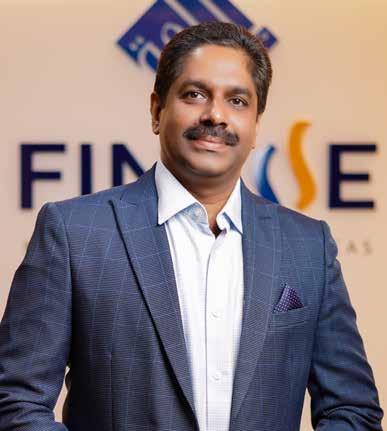
Eljo J P CBO & Director, Finesse
What will Finesse showcase at GITEX 2025 on the AI front? At GITEX 2025, Finesse will showcase its blueprint for leading the AI Revolution, demonstrating how our three integrated pillars—Advising, Enabling, and Securing—empower organizations to transcend traditional digital transformation and achieve true AI-driven strategic advantage that fundamentally reshapes business operations.
Our 1CXO advisory team guides organizations beyond AI hype by establishing the foundational strategy for success. This begins with comprehensive AI Readiness Assessments, followed by strategic AI Transformation Roadmaps tailored to specific business challenges. We establish essential guardrails for responsible innovation by implementing a modern Gen AI Governance Strategy, defining clear AI Guardrails, and ensuring compliance with regulations governing Data Rights, AI Data Privacy & Data Protection from day one. Our approach champions a "data-first" culture, helping clients establish comprehensive data governance and unified data platforms before major AI investments are made.
We translate AI strategy into powerful operational capabilities that create predictive, self-optimizing business ecosystems through technology integration. Our team deploys intelligent systems including AI Chatbots / AI Contact Centers, for enhanced customer engagement, leverages Robotic Process Automation (RPA) for comprehensive hyper-automation, and builds custom solutions through specialized AI Development Services. By integrating sophisticated AI Middleware & Applications and driving comprehensive BI & Analytics Automation across CRM/ECM/ HCM/CPM, Treasury management platforms, we construct the agile, intelligent infrastructure required for organizations to thrive in the AI era.
Guided by our foundational "Security & Ethics by Design" philosophy, our Cyberhub 24/7 CSOC provides comprehensive protection for entire AI-powered landscapes. We deliver robust AI & Gen AI Governance while shifting organizational defense from reactive to predictive using proactive AI Threat Intelligence and automated Security Orchestration, Automation and Response (SOAR) capabilities. Our advanced security architecture includes a Gen AI Broker / LLM Gateway / Firewall solutions to secure generative AI applications and a Zero Trust architecture built on ZTNA / PAM / MFA / IAM to protect critical assets. Our SOC & MDR, MSSP, VAPT , Red Teaming services in the UAE also ensure full compliance with regional data residency laws.
How does your unified AI Revolution framework deliver exponential value compared to fragmented multi-vendor approaches?
The AI Revolution introduces complexities and systemic risks that a fragmented, multi-vendor approach cannot effectively manage, often leading to strategic misalignments, integration gaps, and critical security vulnerabilities that limit transformational potential. Finesse’s primary advantage is our holistic framework, which provides a seamless, end-to-end transformation into the AI era with a unified vision and single-point accountability essential for navigating AI's intricate complexities responsibly.
Our revolutionary process begins with "Advising," where our 1CXO services embed a comprehensive "Security and Ethics by Design" philosophy into the AI roadmap from inception. Our "Enabling" teams then construct technology stacks in perfect alignment with that strategy, while the entire process is continuously protected by our "Securing" pillar—the Cyberhub 24/7 CSOC, which uses AI-powered threat detection and Zero Trust architecture to safeguard complete digital ecosystems.
By unifying strategy, execution, and security under one partner, we eliminate the risks of disjointed approaches, empowering businesses to innovate confidently while managing AI-specific
risks and building stakeholder trust. This integrated model creates compound intelligence effects where each service amplifies others, delivering transformational outcomes impossible with fragmented implementations.
Many businesses are stuck in AI experimentation and failing to unlock strategic value. How does Finesse solve this and turn experiments into a revolution?
The reason most AI initiatives fail to graduate from experimental projects to strategic game-changers is that organizations consistently overlook the most critical prerequisite for success: establishing a modern, coherent, and well-governed data strategy. Organizations frequently attempt to construct sophisticated AI models on fractured foundations of data silos and poor governance—a recipe for inaccurate insights, biased outcomes, and failed projects.
Finesse directly addresses this pervasive challenge through our 1CXO Advising pillar. We don't just talk about AI; we champion the "data-first" culture required to fuel genuine transformation. We begin with comprehensive AI Readiness Assessments to pinpoint foundational weaknesses, then help clients establish comprehensive data governance frameworks while addressing critical policies for Data Rights, AI Data Privacy & Data Protection before major AI investments are made.
From this solid data foundation, we develop a tailored AI Transformation Roadmap that targets specific, high-impact business challenges to deliver measurable ROI and lasting competitive advantage. This comprehensive methodology ensures AI becomes a core engine for competitive advantage, successfully converting isolated technological experiments into full-scale, value-generating business revolutions that redefine entire market segments.
How do you see AI shaping the future of business operations in the region over the next five years?
Over the next five years, AI will move from proof-of-concept to the engine room of business operations in the Middle East. Driven by bold government visions like UAE National AI Strategy, organizations will harness AI to predict, optimize, and adapt in real time—transforming efficiency, agility, and customer value.
End-to-end automation will see supply chains self-manage, factories adapt production instantly, and services become hyper-personalized. AI combined with IoT, 5G, and edge computing will power instant, data-driven decisions for industries from energy and logistics to healthcare and retail. Cyber resilience will also leap forward, as AI-enabled SOCs detect and neutralize threats before they disrupt operations.
But success will hinge on two things: data readiness—unlocking unified, trusted data—and responsible AI governance that ensures compliance, ethics, and transparency. The businesses that get this right won’t just be more efficient—they will create entirely new business models and shape the region as a global hub for AI innovation.
As businesses adopt AI more deeply, what are the critical security and governance challenges they must address to avoid significant risks?
Integrating AI deeply into core operations introduces a new di-
mension of complex security and governance challenges that go far beyond traditional cybersecurity. While AI offers immense potential, it also presents unique risks that leaders must vigilantly address. With the average cost of a data breach reaching $4.35 million globally, robust AI security becomes essential for business continuity.
Critical challenges include:
Model Security, where AI models themselves can be attacked through methods like "data poisoning" or adversarial inputs to corrupt their output and decisions.
Another is Data Privacy and Confidentiality, as powerful Generative AI models can inadvertently expose sensitive personal or proprietary information used in their training data, making robust data anonymization and privacy frameworks non-negotiable.
Furthermore, Ethical AI and Algorithmic Bias is a major concern; an AI model trained on biased data can perpetuate and amplify discriminatory outcomes, leading to significant reputational damage and legal liabilities.
Finally, navigating the complex and evolving global Regulatory Compliance landscape for AI is a critical board-level responsibility.
To mitigate these risks, Finesse’s integrated 1CXO advisory and Cyberhub 24*7 CSOC security services champion a "Security and Ethics by Design" approach, embedding governance, transparency, and robust security into the AI lifecycle from the very beginning to build trust and ensure responsible innovation.
"Finesse’s primary advantage is our holistic framework, which provides a seamless, end-to-end transformation into the AI era with a unified vision and single-point accountability essential for navigating AI's intricate complexities responsibly."
Fissal Oubida, General Manager, Middle East, Africa and India at Lexar, discusses the company’s groundbreaking product launches, regional growth momentum, and its mission to deliver faster, tougher, and smarter storage solutions

General Manager, MEA and India, Lexar
What new products are you unveiling at this year's GITEX?
From the world’s first stainless-steel SD memory cards, to a revolutionary next-gen memory drive that redefines immersive gaming, to a thumb-sized portable SSD that punches well above its weight, Lexar is showcasing a full suite of storage innovations tailored to the needs of photographers, videographers, gamers and content creators. Our pioneering lineup includes microSD cards, internal SSDs, DRAM and portable SSDs that are designed to work seamlessly with multiple devices such as action cameras, tablets, smartphones, and even drones.
Lexar’s consistent excellence in memory card design and innovation has been recognized with multiple prestigious awards
recently, including seven Red Dot Design Awards in 2024, two consecutive TIPA Awards for "Best Storage Media", and seven DGP Imaging Awards in Japan for product performance and innovation. These accolades highlight our commitment to exceptional product design and cutting-edge technology in storage solutions, and we’re excited to bring the world’s lightest, toughest, and fastest memory solutions to consumers in the Middle East.
How has the past year been in terms of growth and expansion?
Lexar is coming off its best couple of years from a business growth and expansion perspective, having registered a fivefold increase in the number of retail outlets carrying Lexar-branded products in the Middle East, Africa and India. Our brand is now featured in over 5000 retail stores in the region – from prominent retail chains such as Carrefour, Lulu, Nesto, Sharaf DG, Virgin Megastore, and Jumbo to small-scale, single-shop retailers. Our presence in the Middle East represents a cornerstone of our continued success and growth globally, and the remarkable pace of our recent expansion reinforces the region’s importance as one of our top-performing markets.
At the heart of Lexar’s retail success is ‘The Lexar Way’ – a unique delivery method where we actively work to foster a collaborative ecosystem, empowering partners throughout the region with the necessary resources, tools and support to accelerate product and channel market disruption. Our strategy revolves around education and consumer engagement, ensuring that our partners are well-equipped to meet the evolving demands of clients and market trends. We believe our growth and expansion in the region owes as much to our unwavering focus on innovation as to our determined efforts to foster a strong brand-distributor relationship, built on open communication and authentic transparency.
There is a surge in high-resolution content creation. How is this influencing Lexar’s product roadmap in terms of speed, capacity, and form factor?
Lexar is investing in the future of memory innovation, pouring millions of dollars into R&D. Our emphasis on creating value for consumers through cutting-edge innovation, coupled with the effective feedback mechanism we’ve put in place to keep abreast of partner needs and consumer expectations, allows us to stay ahead of the technology curve and keep up with changing trends. Our
next-generation memory solutions combine lightning-fast speeds with large capacity, superior reliability and portability to meet the demands of high-resolution, high-performance workflows.
Lexar is showcasing the world’s first stainless-steel SD cards through the ARMOR GOLD and SILVER PRO series. What breakthroughs in performance and experience do these offer users?
The ARMOR GOLD and SILVER PRO cards redefine durability and performance, offering photographers, videographers, and content creators unmatched reliability for their demanding workflows. The stainless-steel construction makes these cards 37 times stronger than standard SD cards, ensuring the cards can endure heavy impacts and withstand drops from heights up to five meters. The cards are equipped with an IP68 rating, offering protection against dust, debris and water damage, and additionally feature anti-magnetic, anti-static X-ray protection. Moreover, users get lifetime access to the Lexar Recovery Tool to help restore accidentally deleted files and formatted cards or drives, plus a limited lifetime warranty.
In addition to the robust armor shielding these groundbreaking SD cards, Lexar also designed them for users seeking unparalleled performance. The ARMOR GOLD SD card boasts a blazing-fast write speed of up to 210MB/s, while the ARMOR SILVER PRO SD card offers a maximum write speed of 160MB/s. Both cards feature a Video Speed Class 60 (V60), allowing users to seamlessly capture 6K footage without interruptions. Furthermore, when paired with a USB 3.2 Card Reader, creators can enjoy even faster transfers up to 280MB/s, streamlining post-production workflows anywhere, anytime.
Discuss how the Professional Go Portable SSD with Hub will benefit the mobile content creators?
The Professional Go Portable SSD with Hub is a revolutionary device that offers the ultimate setup to shoot seamless video from a mobile phone, especially ProRes videos on the iPhone 15, 16 and the latest iPhone 17 series. This ultra-compact SSD packs an incredible capacity of up to 2TB, delivering USB 3.2 Gen 2 performance 1050MB/s read speeds, 1000MB/s write speeds for shooting Apple ProRes 4K 60fps video from an iPhone 15 Pro/ Pro Max or iPhone 16 Pro/Pro Max, allowing users to perform post-production processes right on the drive.
Designed for maximum versatility, the flexible combination of the portable SSD and hub helps expand users’ shooting capabilities for various scenarios using just one equipment set.
How does the Go Portable SSD complement or differ from the SL500 Portable SSD introduced last year as one of the world’s slimmest drives?
Both portable solutions are meant for mobile or on-the-go use and are designed to support Apple ProRes video recording, allowing users to shoot seamless 4K 60 FPS video. While you can’t go wrong with either of these devices, if you often shoot video with a phone, want to attach mics or lights, or need a hub setup plus portability, Professional Go with Hub would be the right choice for you. If, on the other hand, you frequently move large amounts
of data and are using newer laptops or devices that can support USB 3.2 Gen 2×2, then the SL500 Portable SSD will give you more performance for heavyduty tasks.
How is Lexar tailoring its SSD and DRAM portfolio to meet the needs of the gaming segment in the Middle East?
Lexar is showcasing a series of products specifically designed to meet the performance and storage needs of gamers at Gitex Global 2025. Heading our lineup is the ARES RGB 2nd Gen DDR5 Desktop Memory, a revolutionary device featuring premium SK Hynix DRAM chips to deliver higher performance and better stability, indicating a significant partnership between the two brands for their high-end memory lines. With a high frequency of 8000MT/s, capacity up to 48GB and low latency of CL36 (7600MT/s, 32GB Kit), this memory solution provides everything gamers need to plow through opponents. For handheld gaming, we’re introducing the PLAY PRO microSDXC Express Card, with read speeds up to 900MB/s and write speeds up to 600MB/s. The perfect card for the Nintendo Switch 2, the PLAY PRO delivers four times faster performance and accelerated download speeds to level-up users’ handheld gaming experience.
For internal SSDs, Lexar is showcasing two next-generation SSDs engineered for high-end gamers, professional creators and AI developers – the Professional NM990 PCIe Gen5.0 NVMe M.2 2280 SSD and the Professional NM1090 PRO PCIe Gen5.0 NVMe M.2 2280 SSD. Equipped with the latest PCIe 5.0 technology, which offers twice the speed of PCIe 4.0, the Professional NM1090 PRO delivers sequential read speed up to 12,000MB/s and sequential write speed up to 11,000MB/s, and is backed by a DRAM cache and SLC dynamic cache to improve performance and reduce latency.
"At the heart of Lexar’s retail success is ‘The Lexar Way’ – a unique delivery method where we actively work to foster a collaborative ecosystem, empowering partners throughout the region with the necessary resources, tools and support to accelerate product and channel market disruption"
The 2025 Saudi edition of the Future Workspace Summit & Awards served as a dynamic platform to explore AI-first workplaces, human-centered collaboration, and cyber resilience in depth. It was also an occasion to celebrate technology leaders for their outstanding contributions to digital transformation across the region.
The 5th annual Saudi edition of the Future Workspace Summit & Awards, organized by Leap Media Solutions LLC, carried forward the industry dialogue on the evolving future of the workspace through a power-packed lineup of keynotes and panel discussions. The Gold sponsors of the event included Nexthink, Barco, Accops with Bulwark Technologies as well as Mindfire Technologies and Silver sponsor ManageEngine.
Since hybrid work shifted from contingency to default, organizations are re-architecting how people collaborate, how experiences
are measured, and how risk is managed. AI and automation now sit at the heart of that change: they promise massive gains in productivity, experience, and decision-making but they also raise urgent questions about trust, governance, security, and cost control. This year’s program tackled those tensions directly. Across the agenda, speakers explored how AI-driven collaboration and digital employee experience can unlock value; why cybersecurity must move in lockstep with data protection and identity; and how cloud strategy, cost, and compliance must be balanced to sustain transformation. The result was a grounded look at building smarter, safer, more human-centric workspaces with practical guid-

Hady Medhat
Regional Director, Nexthink –Saudi Arabia, Kuwait, Bahrain
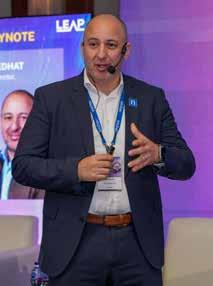
ance, real-world examples, and regional context.
Among the keynotes speakers, Hady Medhat, Regional Director, Nexthink – Saudi Arabia, Kuwait, Bahrain spoke on “AIFirst Workspaces: Securing Productivity and Innovation in the Future of Work.” He outlined how AI-informed insights drive digital employee experience (DEX), reduce friction across endpoints and apps, and protect productivity in hybrid environments, linking experience analytics with security and operational outcomes.
Basel Alsaadeh (Territory Sales Manager – KSA, Barco), the next speaker spoke on “The Evolving Workplace – Creating
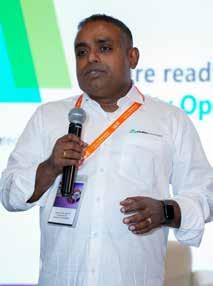
Jishant
Karunakaran CEO, Mindfire Technologies
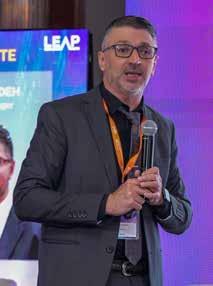
Basel Alsaadeh
Territory Sales Manager KSA, Barco
Spaces that Drive Engagement and Culture.” He showed how immersive, inclusive collaboration and environment design influence culture and engagement, blending AV innovation with human-centered workflows for modern offices and hybrid meeting spaces.
Prasanna R, Director – Systems Engineering, Accops MEA spoke on “Beyond the Perimeter: Secure & Seamless Access.” He focused on identity, context-aware access, and zero-trust principles that enable consistent security for remote and hybrid users, without sacrificing user experience.
Jishant Karunakaran, CEO, Mindfire Technologies spoke on “AI-Augmented Defence: Redefining the Future of Cybersecurity.” He mapped how GenAI and human expertise converge across threat intel, lateral movement prevention, and breach simulation, advocating human-in-the-loop controls and governance for trustworthy automation.
Finally, Dr. Debashis Dutta, a senior Technology consulting practitioner spoke about “Building the Next-Generation SOC: Proactive Threat Hunting and AI.”
He detailed the fusion of AI, automation, and human expertise in modern SOCs, highlighting proactive hunting, AI-assisted triage, and continuous improvement loops.

Prasanna R
Director – Systems Engineering, Accops MEA
The first panel of the day was on ‘Evolving Workplace Collaboration with AI, Cloud Technologies and Emerging Technologies’
This panel explored how enterprises can strategically adopt and integrate AI, cloud, and emerging technologies to create agile, resilient, and future-ready workplaces. The discussion also addressed real-world success stories, the importance of interoperability, and how organizations can balance innovation with trust and compliance.
Hisham Alsayed, Director of Information Technology, NAFT Services Company
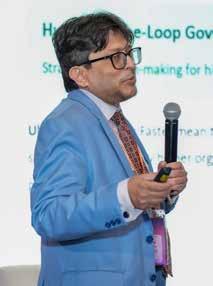
Dr. Debashis Dutta Sr. Advisor


was the moderator for this session and the panelists were:
1. Sameer Joshi, Director Information Technology Services, SPIMACO
2. Ahmad Abu Hamideh, Director of Enterprise Architecture, The Royal Commission for AlUla
3. Faisal Khan, Director of IT, ALNASSR Club Company
4. Hamdan Alshammari, Digital Enablement Director, Confidential
The second panel was on ‘Generative AI in the Workplace: Governance, Ethics, and ROI for Enterprises’
The panel explored how enterprises can integrate GenAI in a way that’s secure, ethical, and aligned with business goals.
The Moderator was Dr. Mansoor Ali Baig,Head, Scientific Computing, King Faisal Specialist Hospital & Research Center and the participants were:
1. Wilfredo Pérez Rivero, CIO, muvi Cinemas
2. Javed A. Akbar, Chief Governnace, Risk & Data Management, TASNEE

3. Dr. Debashis Dutta, Sr Advisor, Confidential
4. Ayoob Al Essa, expert in Data and AI, Confidential
The 3rd panel discussed ‘Data management, security and compliance in the hybrid workplace’
The panel explored practical ways to manage, secure, and govern data in the hybrid workplace, from policy and culture to tools and technology.
Iftikhar Ali Alvi, Head of Special IT projects, Tatweer Education Holding Company was the moderator for the session and the panelists were:
Panelists:
1. Atef Roshdy, Director IT, Al Watania For Industries
2. Majd Aldeen Masriah, Director of Enterprise Architecture at Geidea, GEIDEA
3. Mohammed Alangari, Executive Director of Enterprise GRC –CISO, Confidential
4. Dr. Mohammad Dahman Alshehri, CISO, Taif University
5. Prasanna R, Director System engineering at Accops
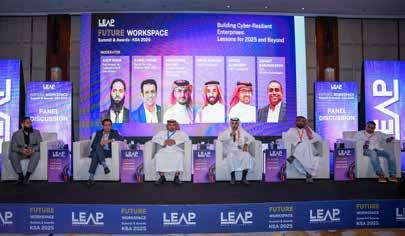


The closing panel discussion of the day was on ‘Building Cyber-Resilient Enterprises: Lessons for 2025 and Beyond’. This panel discussed what it takes to build a truly cyber-resilient enterprise in 2025 and beyond. The panel looked at lessons learnt from recent attacks, how to embed security into business culture, and the role of technology, regulation, and talent development in safeguarding the future.
Aatif Khan, Risk Advisor - AI, Cybersecurity & Data Privacy, Public Investment Fund moderated the session and the panelists were:
1. Kamal Farag, Digital Services Director, Human Resources Development Fund - HRDF – KSA
2. Mohammed Salami, Director of Cyber Security Assurance at Confidential
3. Omar Alnahdi, CISO, Avilease

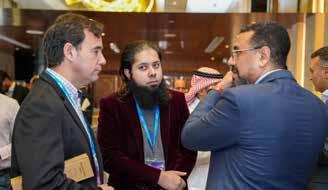

4.
5.
The summit also featured multiple awards segments, recognizing Excellence in Technology Transformation and Excellence in Technology Acceleration, Excellence in CIO Leadership, Excellence in CISO Leadership as well as vendor, distributor and SI awards celebrating organizations and leaders advancing digital and workplace modernization across the Kingdom. Sponsors and partners supported a vibrant exhibitor area, enabling attendees to explore solutions first-hand and continue conversations sparked on stage.
The latest edition of the Future Workspace Summit & Awards delivered a clear message: the future of work is intelligent, secure, and human-centric and it’s being built now.

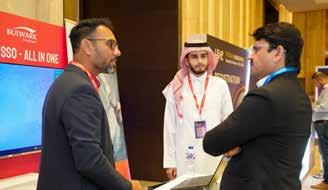

Krishna Sai, Chief Technology Officer, SolarWinds says observability should be seen as a strategic enabler, offering the real-time insights necessary to anticipate issues, optimise performance and support innovation at pace
As Chief Technology Officer at SolarWinds, a company serving customers across nearly every continent, I have the privilege of engaging with technology leaders worldwide. My visit to the Middle East, earlier this year, was truly inspiring. In other regions, much of the narrative around IT strategy is shaped by economic uncertainty, budget constraints and the need to do more with less. Complexity in those markets is often a symptom of legacy systems and reactive change brought on by external pressures.
But in the Middle East, the story is different. Everywhere I went, I saw bold ambition, rapid innovation and a remarkable alignment between government vision and private sector execution. Complexity exists, yes. But there is a notable caveat. In this region, it is a result of opportunity rather than adversity. Saudi Vision 2030, the United Arab Emirates’ AI and digital leadership strategies, and a surge in investment are driving organisations forward faster than in almost any other part of the world.
For those of us who spend our careers thinking about how to build resilient systems, this distinction is crucial. In the Middle East, the challenge is not how to defend against decline but how to maintain agility and control while growing at unprecedented speed.
Throughout my visit, I observed many businesses deploying hybrid and multicloud environments, distributed data centres and edge computing within relatively short periods as they worked to achieve ambitious goals.
This rapid expansion has highlighted the need for resilience and cost control, prompting many organisations to repatriate selected workloads and reassess how they balance agility, governance and spending. The challenge now is to manage this sophisticated, highly distributed infrastructure effectively, turning its scale into a competitive advantage rather than an operational risk.
Indeed, these are positive indicators of growth and maturity. However, they also mean that IT leaders in the region are navigating unprecedented complexity and must maintain visibility, resilience and agility on a large scale.
From Defensive to Proactive: Observability as a Strategic Enabler
This is where observability must evolve. In highly distributed and fast-changing environments, such as those emerging in the Middle East, traditional monitoring is no longer sufficient. Simply reacting to outages or inefficiencies after they occur keeps IT teams at a disadvantage and risks undermining the goals these investments aim to achieve.
Instead, observability should be seen as a strategic enabler, offering the real-time insights necessary to anticipate issues, optimise performance and support innovation at pace. With the right approach, observability helps IT leaders navigate complexity, align their infrastructure with business goals and empower their teams to deliver consistently, even as the technology landscape evolves beneath them.
In this defining decade, shifting observability from a defensive tactic to an offensive capability could be the key difference
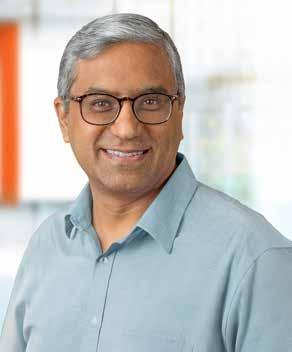
Krishna Sai Chief Technology Officer, SolarWinds
between merely competing and truly leading. By adopting a more proactive observability approach, businesses can strengthen that resilience.
Unified observability across hybrid and multi-cloud environments eliminates gaps between detection and response, enabling faster remediation and better-informed decisions. This allows teams to spend less time firefighting and more time delivering value, both to their customers and to broader national objectives.
What I witnessed during my time in the Middle East convinced me that this is more than just a moment. It is a critical inflexion point that has the potential to be regarded as the defining decade in the region’s digital journey. Few other markets can claim such a strong alignment of vision, investment and execution.
However, sustaining this trajectory will require more than ambition; it demands a willingness to adopt new approaches to resilience, agility and growth. Observability, when applied proactively and strategically, will play a key role in this process. It allows businesses to transform complexity into a competitive advantage and lead confidently in a world that rewards speed and innovation.






Workplace redesign boosts productivity and attracts regional talent, says Murad Ali, Head of Logitech for Business, GCC
Most business leaders today see AI as a critical driver of their future – and they’re not wrong. Used thoughtfully, it can radically optimize efficiency, reduce admin, and free up employees to focus on high-value tasks.
But beyond pure-play technology, there is another means to supercharge the workplace: investment in the office itself. A modern and adaptable workspace supports productivity, inspires creativity, and attracts people to the office.
The way the region works is undergoing profound change. In the UAE, nearly half of employees now work remotely in some form – a clear sign that flexible work is no longer a fringe perk but part of the mainstream employment landscape.
From high-profile trials of four-day workweeks to the rapid adoption of hybrid models, regional office culture is being reshaped to meet the needs of a more dynamic workforce.
With the rise of smart workplace technologies, organizations now have the tools to create healthier environments, elevate the employee experience, and get the best value from their office investments.
But how does this transformation actually happen?
This article explores the ways in which workplaces and workforces are changing, plus the innovative technologies helping businesses to adapt.
According to a recent survey by Gensler, UAE workers are increasingly dissatisfied with traditional office environments when they don’t meet certain criteria. They want offices that support both collaboration and focus. There’s also a trend toward workplaces that offer thoughtful layouts and amenities.
An earlier extensive study by PwC across the Middle East found that employees show a strong preference for hybrid or remote arrangements over full-time office work. Compared to global averages, regional workers place a higher premium on well-being and flexibility.
In a bid to attract the brightest talent, forward-thinking employers are already responding to changing staff needs. However, diversity in preferences can make workplace execution a challenge.

Murad Ali Head of Logitech for Business, GCC
The CCS Employee Workplace Technology Survey found that over half of employees said social interaction and a sense of community were the most important advantages of corporate offices.
In contrast, over half of employees surveyed by Appspace said that going into the office “feels like a waste of time”.
In short, a one-size-fits-all approach to workplace design is no longer feasible. Companies must prioritize flexibility and employee experience to unlock significant benefits today, as well as the ability to adapt to evolving workplace requirements.
The fact is, most employees require a range of environments, including quiet zones for deep focus, available desks for productivity, huddle areas for quick discussions, and larger, well-equipped spaces for collaborative meetings.
Key features of smarter workplaces
• Clear, easy-to-use room and desk booking systems to ensure employees can easily find and reserve the spaces they need.
• Collaboration technology that can be quickly moved between spaces to cater to different meeting needs.
• Smart occupancy sensors that help manage shared spaces effectively, automatically releasing unused rooms to maximize availability and minimize wasted resources.
• Integrated scheduling systems to keep employees informed, enhancing their ability to coordinate with colleagues and make the most of their time in the office.
Ultimately, a flexible workplace should be just that. The idea isn’t simply to implement and forget but to learn and adapt. Organizations have a responsibility to stay on top of trends and adjust spaces accordingly to ensure the best outcomes.
Flex spaces and flex desks are redefining modern workplaces. Flex desks, similar to hot desking, utilise shared stations to optimize space, enabling employees to secure a desk quickly through docking and booking systems. This ensures fluctuating attendance is managed efficiently while maximizing office technology.
Flex spaces go beyond desks, offering modular, open-concept areas for collaboration – from small teams to groups of 20 or more. These spaces can be equipped with scheduling panels and mobile, all-in-one devices that can be repurposed instantly, whether for video, hybrid or in-person meetings.
Together, flex desks and spaces create adaptable, functional environments that attract employees back to the office.
Efficient room and desk booking is at the heart of a seamless flex space experience. For flex desks, all that’s typically required is to book in advance (or on an ad hoc basis) and plug in a laptop to get started.
Rooms and open spaces can be booked the same way, offering a simple laptop connection or dedicated device through which meetings can be joined.
Interactive tools can also help employees meet and collaborate more effectively when on-site. Modern technology solutions enable office navigation and booking by providing a real-time view of office layouts via a touch display. This gives employees a straightforward way to find desks, spaces, and even coworkers using zoomable touch controls.
With smart, integrated, and flexible solutions, workplaces are not only easier to navigate and more enjoyable to work in but are also capable of eliminating manual processes.
Standalone sensors or those within devices can support workplace automation that carries out common actions automatically. Simple automations like these can make standard activities like reserving and freeing up spaces seamless.
When people are detected in a space, a reservation is automatically created. When those people leave, the reservation is removed. This works whether the room is being used for a video meeting or an in-person session.
By embracing innovative approaches and deploying the right tools, your business can create flexible, optimized spaces that truly work.
The result is an office that not only maximizes the value of your investments and adapts to changing needs, but also empowers employees to thrive – because when your people perform at their best, so does your business.
"A one-size-fits-all approach to workplace design is no longer feasible. Companies must prioritize flexibility and employee experience to unlock significant benefits today, as well as the ability to adapt to evolving workplace requirements."
Baryal Noor, IT Center Manager (EMEA-MEA), AERZEN ME - FZE shares a reflective perspective on how technology, AI, and human values continue to shape the evolving landscape of IT and leadership.
Technology is not cold metal or mere code, it is the extension of our imagination. It is no longer separate from our daily lives, it’s an environment we live in. It now shapes how we communicate, work, think, and evolve. Beneath the code and platforms, I see something deeply human: a canvas for our ideas, a mirror of our intent, a reflection of human ambition.
Technology and the Search for Meaning
Technology, at its core, is a tool for human expression, much like poetry or art. During the Renaissance, art and philosophy took deep roots in cultural innovation, questioning human values and changing our thoughts forever.
Similarly, AI and automation will continue to shape our thinking. AI is already autocompleting our words, sentences, sorting mails, telling us which music to hear next, and much sooner will autocomplete our thoughts, which means our thinking will carry AI influence. But we need to decide how much of that autocomplete we allow into our lives. That’s where meaning will be derived.
AI and the Changing Role of IT Management
AI is redefining IT management from being reactive to becoming predictive. Instead of responding to incidents, we now anticipate them. AI handles complexity at scale, ticket routing, threat detection, capacity forecasting, freeing human minds for strategy, creativity, and connection. The engine room is now automated, allowing the crew to focus on navigation.
Security in a Connected and Remote World
Security is no longer just about protecting data, it’s about preserving trust. As our systems grow more complex, so does the human element behind them.
Chaos theory explains it well: some systems appear random but follow patterns so sensitive that the smallest changes lead to vastly different results.
How do we secure not just systems but trust? Imagine frameworks that adapt not only to evolving threats but also to how people behave and interact. In this way, security becomes both a technical foundation and a human promise.
Standardization is like the blueprint of a great city; it allows different buildings to rise in harmony. In a multinational context, it ensures security, reliability, and consistency. But like architecture, there’s beauty in local expression.
So, we create frameworks. As the Arabic proverb says, “Trust in God, but tie your camel.” Standardization is how we tie the camel in our digital world.
The Next Five Years in IT
It will feel like we’re constantly arriving, only to realize we’ve just begun again.

Baryal Noor IT Center Manager (EMEA-MEA), AERZEN ME - FZE
Technology will become even more invisible, more intuitive. AI will thread itself into daily tools, decisions, and workflows, not as something we notice but something we trust. It will feel less like managing systems and more like orchestrating intelligence. Yet, the human layer will matter more than ever: ethics, purpose, empathy, culture.
Prepare for ambiguity. Prepare to lead through change that doesn’t come with instructions. The job won’t be to control everything, but to build frameworks that adapt, teams that learn, and cultures that evolve. Expect a rise in intelligent automation, edge computing, sovereign cloud, and AI agents.
Also prepare for new questions—about trust, privacy, transparency, and responsibility.
In the next five years, the most valuable IT leaders won’t just be tech-savvy. They’ll be storytellers, diplomats, and sense-makers.
AI won’t just change what IT does—it will change who IT becomes. Routine tasks, ticket handling, monitoring, and reporting will be automated. The real shift will be from operations to insight, from support to strategy. IT will become less reactive and more anticipatory. We’ll move from solving problems to preventing them, from building systems to designing intelligence. The IT department will evolve into a nerve center of business foresight, where data, ethics, and innovation intersect.


Muhammad Zahaib Nabeel, a technology leader and PMO expert with Yas Holding explores how traditional corporate hierarchies are breaking down and being replaced by hybrid organizational structures where human teams work alongside AI agents

Muhammad Zahaib Nabeel
Technology leader and PMO expert, Yas Holdin
Organizational charts are being rewritten.
Not of ink, but of AI agents.
For decades, the corporate pyramid was based on layers of specialization and middle management. That model made sense when coordination, oversight and reporting relied almost entirely on people. But in today’s world of speed, complexity and global scale, it is being stretched beyond what it can handle. The new reality is compact teams , flatter structures and hybrid teams where leaders have to manage both humans and AI together.
This shift is not about replacing people. Instead, it’s about increasing productivity by complementing humans with AI workers to scale up operations,reduce ineffecincies, and ensure robost acceletarted outcomes. Hybrid Org Chart is no longer theoratical , infact it has already become a reality of many organizations.
The traditional hierarchy was designed for efficiency: cookie-cutter functions, managers monitoring execution and decisions cascading down.
That model worked when:
• Information flow was slow.
• Oversight was manual.
• Predictibility valued over Agility.
But disruption is now constant. Supply chains ebb and flow, regulations tighten, technology cycles change every quarter. The pyramid, meanwhile, is difficult to maintain, it is slow, expensive and fragile.
AI agents are not in the future, they’re already a thing. These are independently operating systems that have the ability to analyse, decide, and take actions in the context of some sphere of activity. Consider them digital colleagues.
Practical examples:
• Microsoft Copilot summarizing meetings and writing reports.
• Salesforce Einstein forecasting pipelines and handling customer queries.
• IT service bots which resolve tickets without escalation.
• AI financial models producing realtime insigts.
These agents don’t just automate,they participate. Embedded in work flows, they scale knowledge work to exceed human capacity.
In this new structure:
• Lean,Agile and corss-functional human teams.
• Embeded Ai Agents across organizational functions
• Lean middle management as AI taking over roles of cordination and monitering.
• Executives now lead hybrid teams; part human and part digital.
New roles are emerging:
• AI Operations Manager to align agents with KPIs.
• Hybrid Team Leader to lead outcomes on people and AI workers.
• Governance Specialist to oversee the compliance and accountability aspect.
The effect is transformational: decision cycles shorten, reporting lines are flattened, and higher productivity.
This shift requires the leader to move from managing tasks to orchestrating outcomes. Three big changes:
• Trust and accountability: AI decisions should be transparent and explainable.
• Culture shift: Staff need to see AI as co-workers, not a threat.
• Acquired skills: Leaders transition from managing process to managing ecosystem, balancing people, data and algorithms.
Leaders who learn and apply will not just ride the wave of change, they will re-define it.
The shift is already being quantified by analysts:
• Gartner forecasts that by 2026, one in five knowledge workers will collaborate with AI agents.
• Generative AI, McKinsey estimates, could unlock $4.4 trillion a year in annually productivity.
• IDC predicts that by 2027, 40% of large enterprises will formalize the management of AI agents as a core leadership competency.
• The Middle East is fast-paced.
• UAE’s National AI Strategy 2031 aims to enhance the role of AI as a force multiplier of workforce.
• In Saudi Vision 2030, AI is incorporated in economic diversification.
Throughout the GCC, companies are implementing AI as a part of core operations, not merely in the form of pilots.
How can organizations prepare? Three immediate steps:
1. Audit Workflows: Idnetify high-volume, repetative processes where AI can complement; customer support, finance, procurement, or compliance.
2. Pilot Hybrid Models: Start small. Use AI agents in one centre with a human team leader over digital and human agents. Document learnings before scaling.
3. Upskill Leaders: Train managers in “hybrid leadership.” It’s not just about delegation it’s about governance and motivation in teams where half the contributors never make it to a coffee break.
The org chart is no longer a rigid pyramid. It’s evolving into a dynamic system where people and AI agents work side by side. This is not about human obsolescence but about amplification. People focus on creativity, empathy, and strategy, while AI agents handle precision and scale.
Leaders who are early adopters of this model will gain in efficiency, and more importantly, but more importantly, they will redefine leadership itself in the age of AI.
"This is not about human obsolescence but about amplification.
People focus on creativity, empathy, and strategy, while AI agents handle precision and scale"
Today, we see the coming of age of DevOps through the rise of platform engineering, a new function for a more mature era in application development writes Fred Lherault, Field CTO EMEA/Emerging at Pure Storage
In software engineering, the Golden Path aims to provide the smoothest way forward via a self-service template for common tasks. It is enabled by platform engineers — who provide developers with the simplest possible internal developer platform and the tools they need to deliver innovation.
Here we look at the emerging discipline of platform engineering, the benefits it brings to application development via easier and faster access to services and resources, in particular using modern data management platforms built on Kubernetes containerised environments.
Giving developers what they want Automation is one of the key principles of DevOps, since the quick pace of changes it drives are incompatible with “human in the loop” workflows.
The mode of operations preferred by developers can often be boiled down to 3 main asks:
● Instant access to resources
● Instant results
● Full self-service
Using the above as the “north star” when building services geared towards technical profiles is a great way to enable innovation and ensure fast adoption. While providing instant resources and results might not be always possible, getting as close as possible to instant will drive greater satisfaction.
Platform engineering treats the developer as its primary customer
Today, we see the coming of age of DevOps through the rise of platform engineering, a new function for a more mature era in application development, that provides a suite of self-service tools to empower developers. Platform engineering operates behind the veil to provide an easy-to-use, self-service catalogue of services and infrastructure components to

Fred Lherault Field CTO EMEA/Emerging, Pure Storage
Data management capabilities are key to platform engineering because they enable exploration and testing in realistic conditions, for example using an instant copy of production data instead of a somewhat unrealistic synthetic data set.
Ideally, the data management capabilities will also be designed with self-service in mind, and deliver access to data in a highly available, reliable, elastic, multi-tenant and secure manner.
Portworx from Pure Storage is an example of such a modern data platform. Fully integrated with Kubernetes, it allows the developer to easily get access to persistent data options but also to data sets themselves through instant data cloning, even enabling the use of self-service instant snapshot creation and restore so that developers may experiment with changes and roll back to previous states quickly and easily.
support the day-to-day development experience.
Best practice platform engineering aims to help application developers get onboard and start building faster by providing everything that they need to experiment, develop, test and deploy. The platform made available to these developers often takes inspiration from the services popularised by the public cloud and its mode of operation. It is designed to provide instant access to not just the latest and greatest tools and software that underpin innovation, but also provide easy access to the data itself, protected by pre-determined guardrails and security protocols.
The ideal developer-focused platform also includes data management. It may build on top of Kubernetes as the means to orchestrate, deploy, run and scale cloud-native applications as well as to manage the data services required for those applications.
Additionally, Portworx Data Services provides a catalogue of curated data services, simplifying deployment into just a few clicks or a single API call, so that developers can deploy or scale these data services easily with the optimal data storage configuration and protection.
This foundation brings these easy-to-specify toolchains and data services to the developers, so that they can easily use them as building blocks, even if they don’t have extensive knowledge of Kubernetes or how to deploy a given database engine in a secure and scalable manner.
Platform engineering enables the Golden Path
Platform engineering teams are busy working unseen in the background to bring the self-service Golden Path to application development. With Kubernetes as the orchestration framework, containers and data services as key resources, the platform engineers can finally deliver fully on the vision of increased agility and greater productivity of DevOps.

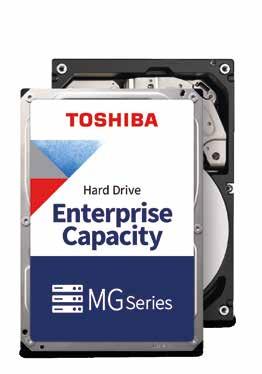

Lexar’s two new products to its ARMOR series: the ARMOR GOLD SDXC UHS-II Card and ARMOR SILVER PRO SDXC UHS-II Card. As the world’s first stainless-steel SD memory cards, these new innovations redefine durability and performance, offering photographers, videographers, and content creators unmatched reliability for their demanding workflows.
The ARMOR GOLD and SILVER PRO SD cards were specifically designed to address common issues faced by professional photographers, who often experience physical damage and wear with traditional plastic cards. The ARMOR series SD cards are 37 times stronger than normal SD cards, and deliver far greater strength and resilience. They provide exceptional protection against bending, breaking, and everyday wear. With an IP68 rating, the cards are dust-resistant, water-resistant, and capable of withstanding drops up to 5 meters, making them ideal for outdoor use.
Despite being made from stainless steel, the ARMOR SD cards fully meets thickness requirements of the SD Association (SDA), ensuring that it can be safely used in the camera slot without causing damage to the camera slot. Additionally, the ARMOR card has undergone rigorous testing in the Lexar Quality Laboratory to guarantee it won't experience issues due to overheating or static electricity.
In addition to the robust armor shielding these groundbreaking SD cards, Lexar also designed them for users seeking unparalleled performance. The ARMOR GOLD SD card boasts a blazing-fast write speed of up to 210MB/s, while the ARMOR SILVER PRO SD card offers a maximum write speed of 160MB/s. Both cards feature a Video Speed Class 60 (V60), allowing users to seamlessly capture 6K footage without interruptions. Furthermore, when paired with a USB 3.2 Card Reader, creators can enjoy even faster transfers up to 280MB/s, streamlining post-production workflows anywhere, anytime.
• Stainless-Steel Build, 37X Stronger than Normal SD Cards
• IP68 for Dust & Water-Resistance, Drop-Resistant up to 5M
• Video Speed Class 60 (V60) to Seamlessly Capture 6K Footage
• Pairs with USB 3.2 Card Reader for Fast Transfers up to 280MB/ s1
• Simplified Design for a Sturdier Card; No Ribs or Write-Protection Switch
• Lexar Recovery Tool Helps Restore Accidentally Deleted Files
This revolutionary device offers the ultimate setup to shoot seamless video from a mobile phone, especially ProRes videos on the iPhone 15 Pro/Pro Max and iPhone 16 Pro/Pro Max.
Compact, about the size of your thumb, the Lexar Professional Go Portable SSD measures a mere 1.00'' x 1.71'' x 0.32'' and weighs only 13 grams. Still, it packs a capacity of up to 2TB, delivering USB 3.2 Gen 2 performance 1050MB/s read speeds, 1000MB/s write speeds for shooting Apple ProRes 4K 60fps video from an iPhone 15 Pro/Pro Max or iPhone 16 Pro/Pro Max and perform post-production processes right on the drive. 1
The flexible combination of the portable SSD and hub, which features four USB Type-C ports, along with the included adapters and cables, makes it easy to add accessories. It also comes with a male-tofemale adapter, a male-to-male adapter,
and a cold shoe adapter cable for maximum versatility. This setup expands your shooting capabilities for various scenarios using just one equipment set.
Not only does it offer plug-and-play convenience, but the portable SSD is also rated IP65, durably dust- and water-resistant, so you can confidently use it in various locations hassle-free.2 It is also drop-resistant up to 1 meter to handle everyday accidents and comes with a silicone case for superior protection from the outside in.
• One of the worlds lightest portable SSD – weighing only 13gms
• Ultra-compact for spontaneous creativity anytime, anywhere
• The portable SSD and hub with four USB Type-C ports provide ultimate flexibility for customizing your setup to suit the shoot

• Captures brilliant Apple ProRes footage and stores it with ease
• A cable-free plug-and-play Type-C connector means no tangled, cumbersome cables
• Blazing-fast performance up to 1050MB/s read and 1000MB/s write speeds for seamless 4K recording, no dropped frames, and swift backups1
• Ready for travel – dust and water-resistant (IP65 rated), and drop-resistant up to 1 meter2
• 1TB and 2TB storage options


This all-in-one, outdoor-ready camera delivers superior image quality in 41 MP with exceptional light sensitivity. It’s available with a wide lens for open areas or a tele lens for surveillance from a distance. Built on a dual Axis system-on-chip, this device delivers extreme detail over great distances and excellent forensic value. It offers 41 MP at 15 fps or 8K at up to 30 fps. And a 4/3” image sensor ensures exceptional low-light performance. With a custom-made, tele Canon lens, it’s perfect for long-distance surveillance and delivers extremely high pixel density. Electronic image stabilization (EIS) ensures smooth video in situations where a camera is subject to vibrations, for instance, at sports arenas or windy harbors. Furthermore, Axis Zipstream reduces bandwidth and storage requirements without compromising image quality.
With a wide (12 – 24 mm) Canon lens and 90°-44° horizontal field of view, AXIS Q1809-LE is perfect for surveillance in wide, open areas. It offers 2x zoom and outstanding light sensitivity to ensure excellent forensic details. Plus, white light IR LEDS (850 nm) let you switch to white light to deter unwanted activity.
With a tele (50 – 150 mm) Canon lens and 21°-7° horizontal field of view, AXIS Q1809-LE is perfect for great details at long distances. It offers an additional 3x zoom—ideal for identification purposes. Plus, Optimized IR allows for surveillance in complete darkness up to 100 m (328 ft) without the need for extra lighting.
This powerful camera offers everything you need and is out-of-

the-box ready to use. Enclosed in a robust aluminum casing, it also includes a mounting arm for easy installation. And a spacious back box ensures secure cable management. It features a custom-made, tele (50 – 150 mm) Canon lens and 21°-7° horizontal field of view. With 3x zoom, it’s ideal for identification purposes. In addition, thanks to PoE out, you can connect and power another device without any additional cabling. This eliminates the need to rent extra ports and simplifies installation.
• Out-of-the-box and outdoor-ready
• Superior image quality in 8K
• High light-sensitive 4/3” sensor
• Wide or tele Canon lens
• Built-in cybersecurity with Axis Edge Vault
Dell Technologies has long been a trusted partner for organizations seeking to strengthen their cyber resilience. Its strategy is built on three pillars - reducing attack surfaces, detecting threats, and enabling rapid recovery.
The Dell PowerProtect portfolio sets the standard with Data Domain purpose-built backup appliances, delivering robust cyber resilience and management both on-premises and across multicloud environments. Trusted by over 15,000 customers worldwide, Data Domain safeguards the most vital assets with unmatched reliability. With a focus on continuous innovation, Dell ensures its solutions stay ahead of evolving threats, providing resilience and peace of mind.
The PowerProtect Data Domain All-Flash appliance delivers
a groundbreaking solution that redefines what’s possible in cyber resilience. Built on the trusted Data Domain platform, this high-performance appliance delivers unmatched speed, efficiency and security, empowering organizations to modernize their cyber resilience strategies.
Highlights:
• Unparalleled performance: Up to 4x faster data restores2 and 2x faster replication2, ensuring minimal downtime during recovery. The appliance also delivers up to 2.8x faster analytics to validate data integrity in a PowerProtect Cyber Recovery vault3.
• Space and energy efficiency: Occupies 40% less rack space4 and provides up to 80% power savings2 without compromising performance, while achieving up to 65:1 data reduction5.
The D-Link DIR-BE981 is a next-generation Wi-Fi 7 Mesh Router engineered for ultra-fast, reliable, and intelligent connectivity across modern homes and offices. Delivering lightning-fast tri-band speeds of up to 10 Gbps, it ensures seamless 4K/8K streaming, low-latency AR/VR gaming, and rapid downloads. Powered by advanced Wi-Fi 7 technologies such as MultiLink Operation, 4K-QAM, and 320 MHz channels, it achieves exceptional throughput and minimal latency across the 6GHz, 5GHz, and 2.4GHz bands.
Equipped with a 10 Gbps WAN port, link-aggregated LAN ports, and seven internal high-power antennas with beamforming, the DIR-BE981 offers expansive coverage, enhanced capacity, and stable performance even in dense environments. It integrates seamlessly into a Mesh Wi-Fi network, maintaining uninterrupted connectivity as users move between rooms.
Security and control are built-in, with WPA3 encryption, IEC 62443-4-1 certification, Advanced Parental Controls, and guest Wi-Fi management. Setup and monitoring are simplified through the
D-Link Mobile Connect+ App. Scalable and future-ready, the DIR-BE981 is designed to handle bandwidth-intensive IoT environments, delivering a truly connected, high-performance, and secure smart home experience.
Highlights:
• Experience Lightning-Fast 10 Gbps1 Tri-Band Speeds ensuring your devices operate at maximum efficiency.
• Enjoy seamless 4K/8K streaming, immersive AR/VR gaming, and rapid downloads with ease.
• The latest Wi-Fi 7 technology incorporates Multi-Link Operation Multi-RUs, 4K-QAM, and 320 MHz channels.
• It achieves speeds of 5760 Mbps on the 6GHz band, 2880 Mbps1 on the 5GHz band, and 1030 Mbps1 on the 2.4GHz band.
• Featuring 1× 10 Gbps WAN port and 4× 1 Gbps LAN ports with link-aggregation, this setup surpasses the 1G bottleneck, propelling your devices
• With 7× Internal high-power antennas, proprietary Wi-Fi optimization, and Beamforming technology, you experi-
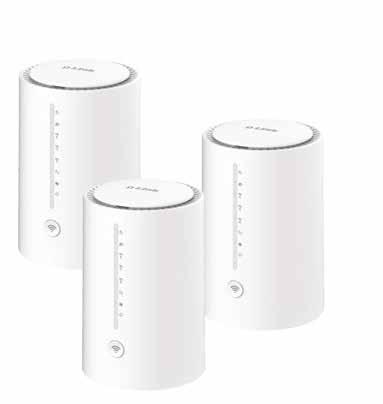
ence expanded coverage, increased capacity, robust and reliable connections, and minimized interference
• Mesh WiFi network throughout your home, ensuring uninterrupted connectivity and eliminating drops or lag when transitioning between signals.
• Advanced Parental Controls protect your kids online with instant monitoring, content filters and customized settings for every connected device

• Advanced security features: Built-in data immutability, encryption, and hardware root of trust ensure that data remains tamper-proof.
• Seamless integration: Native compatibility with Dell PowerStore and PowerMax for fast, efficient, and secure backup and recovery, plus an extensive backup software ecosystem.
• Broad DD Boost ecosystem: Enables seamless integration, advanced efficiency, and collaborative innovation for greater flexibility and growth.
GenAI Capabilities Rapidly Become Expected Features as Providers Compete on Infrastructure, Models, Applications, and Services
The AI vendor race is restructuring the business of tech, and every tech provider must reevaluate what it takes to compete and win in this evolving landscape, according to Gartner, Inc., a business and technology insights company.
With various AI vendor races taking place across the AI technology stack, Gartner is examining which vendors are positioned to win these races, ranging from large vendors, to rising contenders to new entrants.
In the Gartner report The AI Vendor Race: What It Takes to Win in Volatile Conditions, Gartner analysts explain that traditional provider-enterprise value relationships will not drive AI adoption, and
it isn’t sufficient to sell an AI tool and expect customers to find value.
“The AI vendor race is not a single race with a clear finish line, but rather a series of overlapping competitions, where the endgame can range from market leadership to technological breakthroughs, or simply maintaining relevance,” said Anthony Bradley, Group Vice President at Gartner.
“Vendors must pay close attention to the frequent shifts in the market to gain advantage and protect their position,” said Bradley. “It requires an understanding of competitor capabilities and their demonstrated and likely moves in the race. Ven-
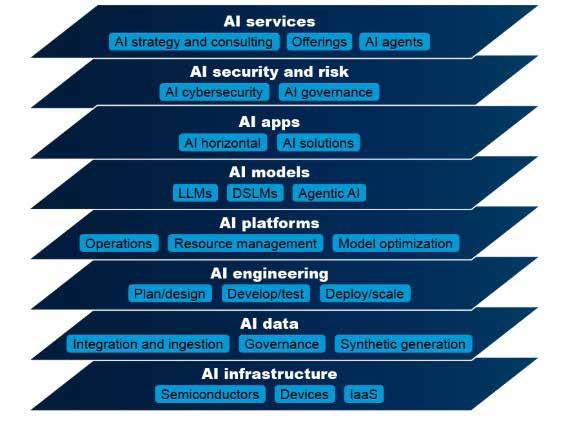
Source: Gartner
dors must also have a deep understanding of AI adoption behaviors and how they’re positioned in the race against competitors to meet or even drive demand.”
The AI race is always changing. GenAI advantages are eroding much faster than other innovation cycles, putting more pressure on tech providers. For example, leaders face a rapidly maturing GenAI market, where in less than 36 months, GenAI capability will become a baseline requirement for offerings. In fact, every software market has already surpassed first-mover advantage, and by 2026, more money will be spent on software with GenAI than without.
The GenAI models market is projected to grow by 149.8% in 2025, surpassing $14 billion. By 2028, Gartner expects the market to stabilize at 38% annual growth, as GenAI becomes increasingly embedded in applications. Meanwhile, the global market for AI-optimized servers is expected to grow by 90.9% in 2025, and by 2027, nearly all premium computing devices will be AI-enabled.
“Providers must pivot from functional, use-case-oriented AI to approaches that deliver real business outcomes tied to mission-critical initiatives,” Bradley added. “Less than one in five GenAI projects will achieve their desired business value through 2026. To close this gap, product leaders need to integrate targeted business outcomes into product engineering, marketing, and implementation. Those who fail to make this shift will not remain competitive.”

